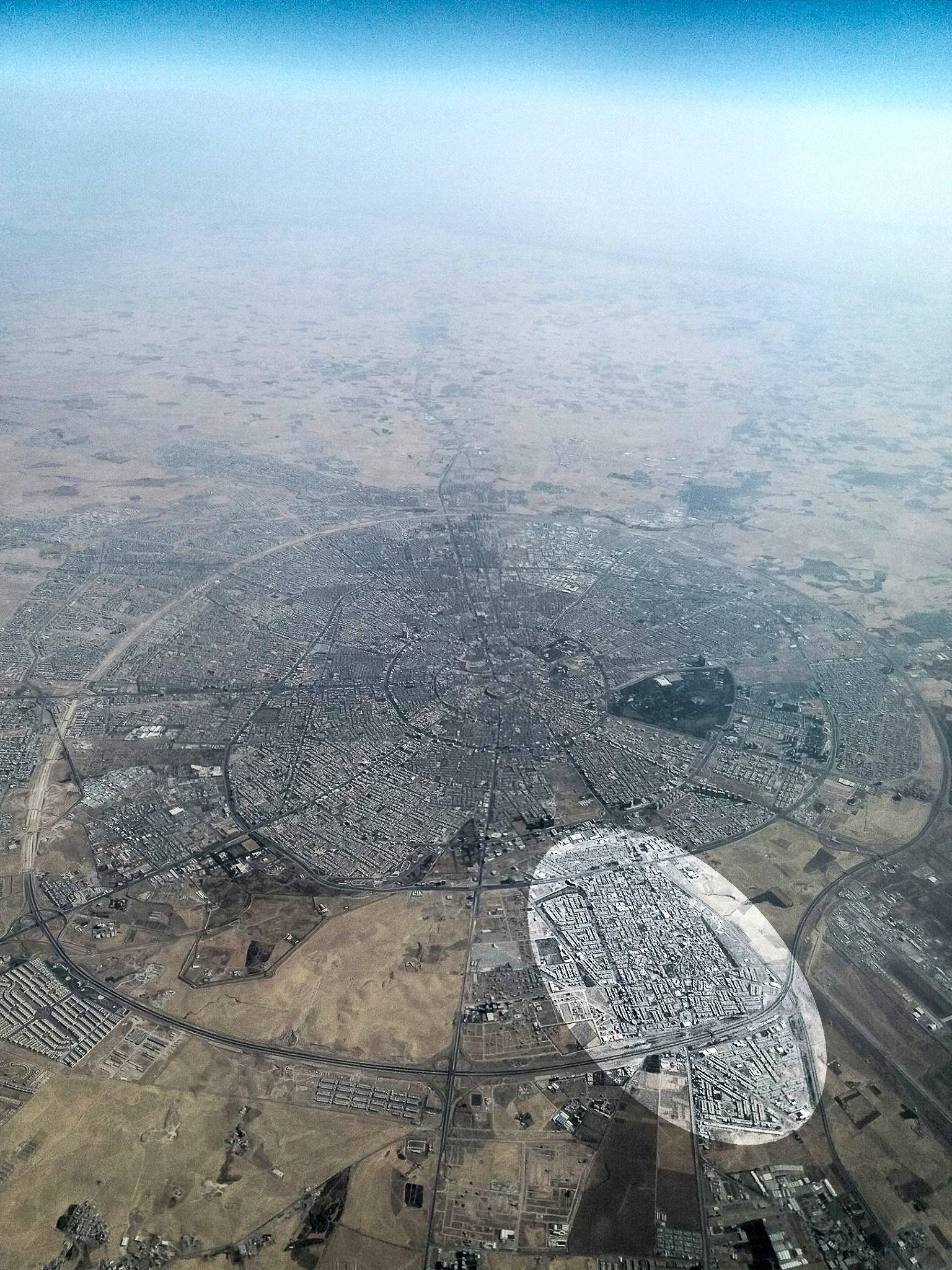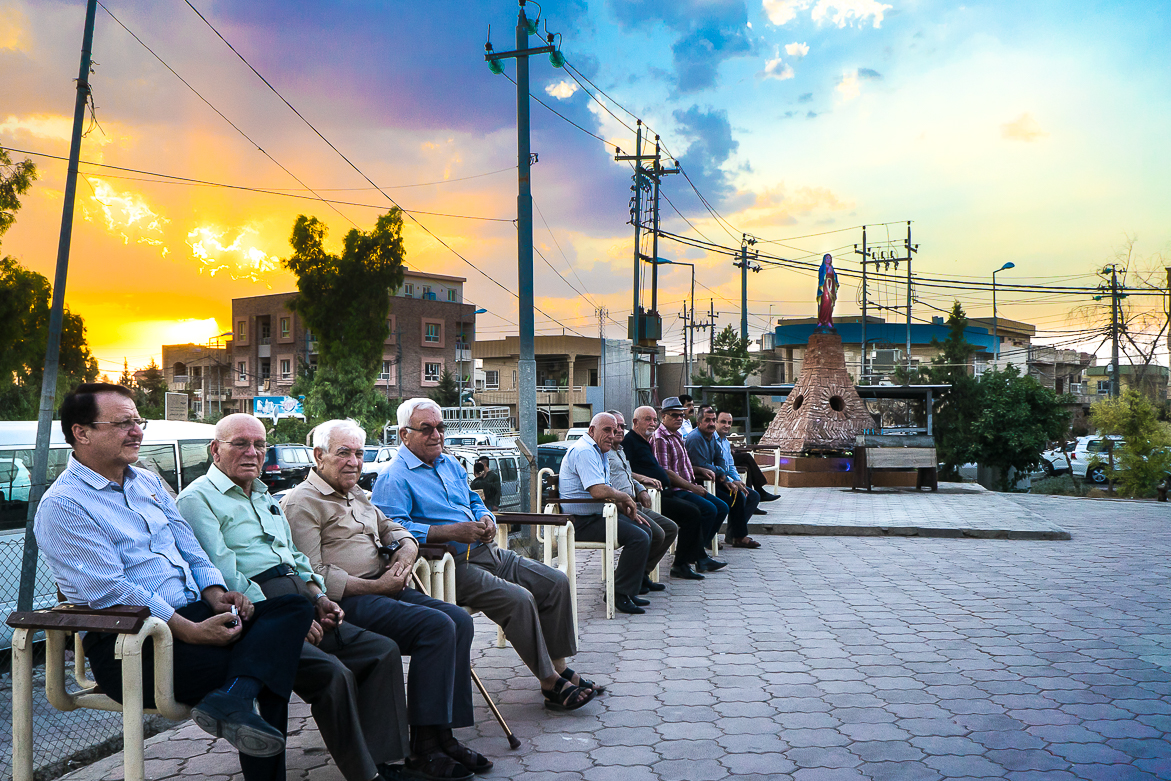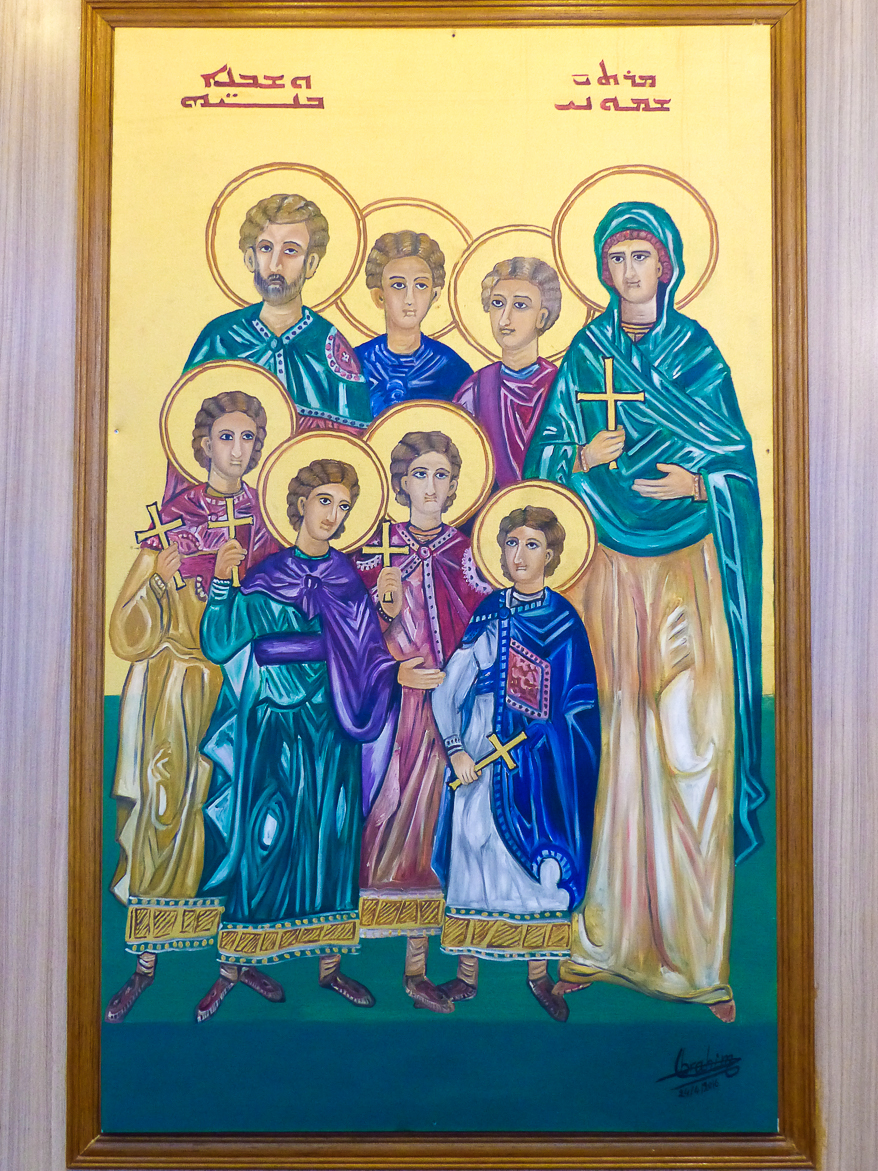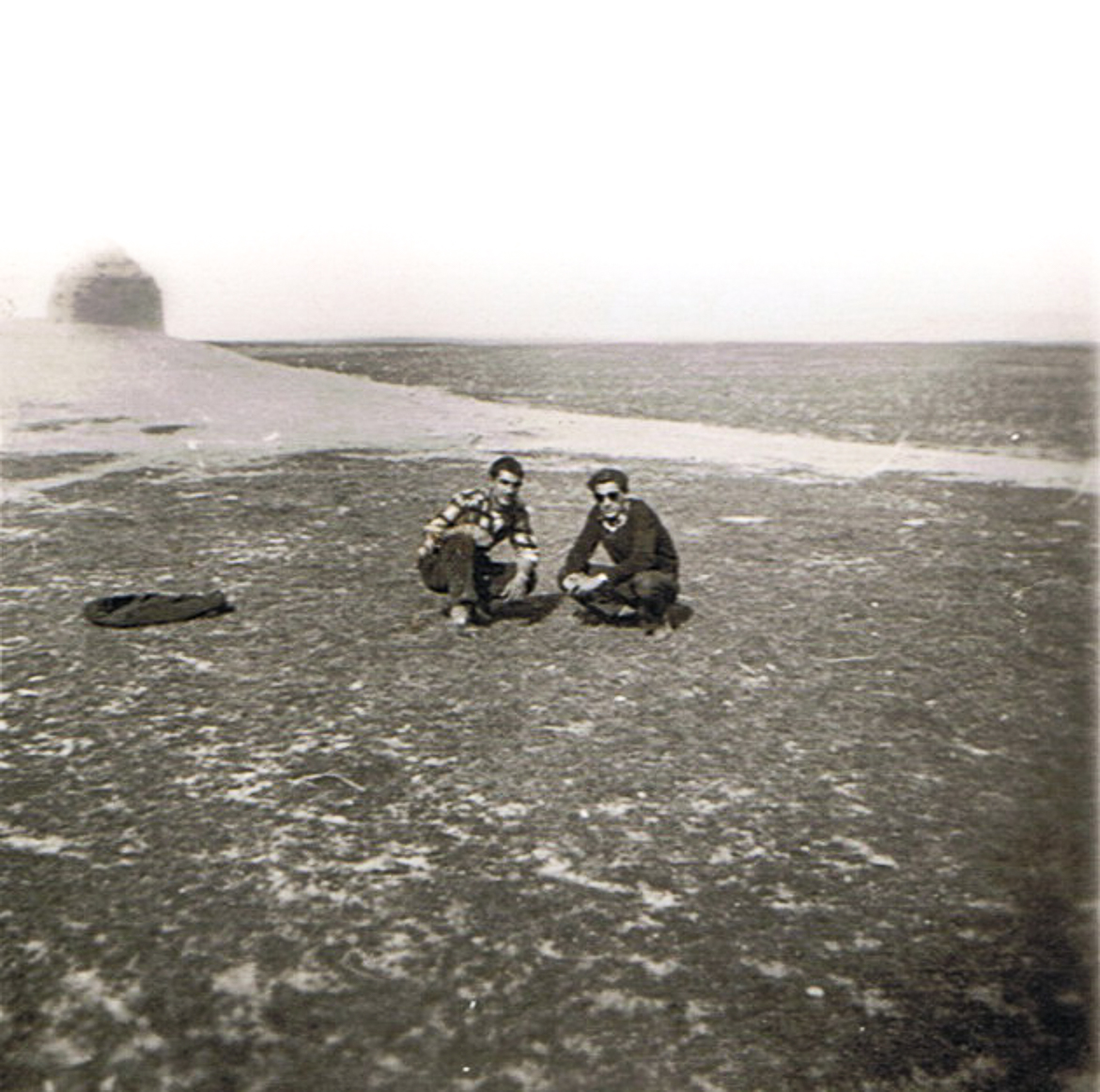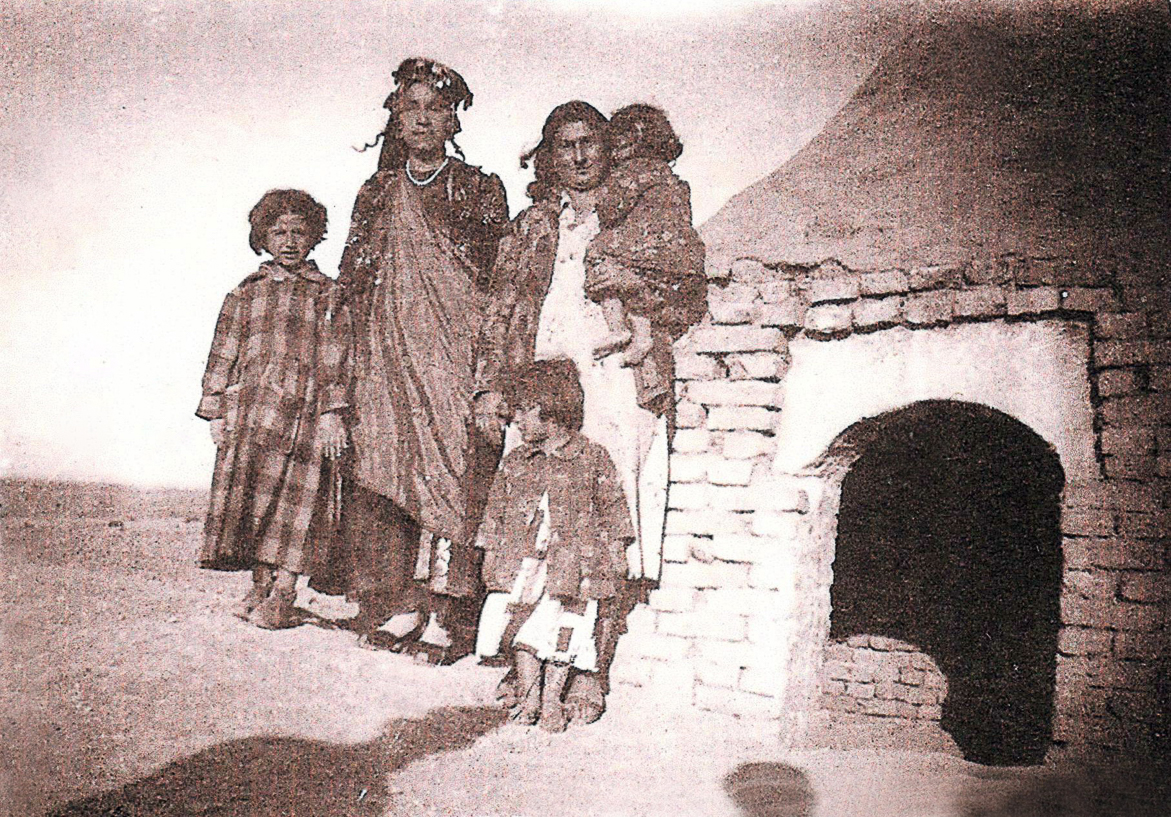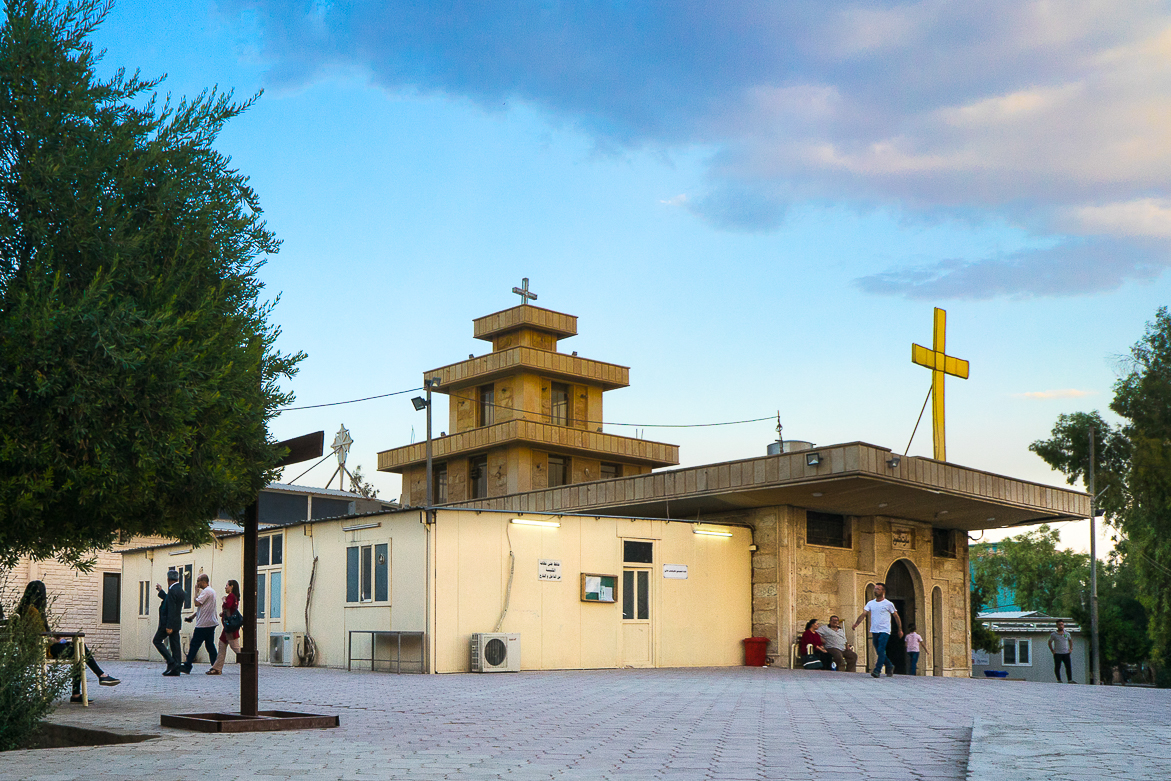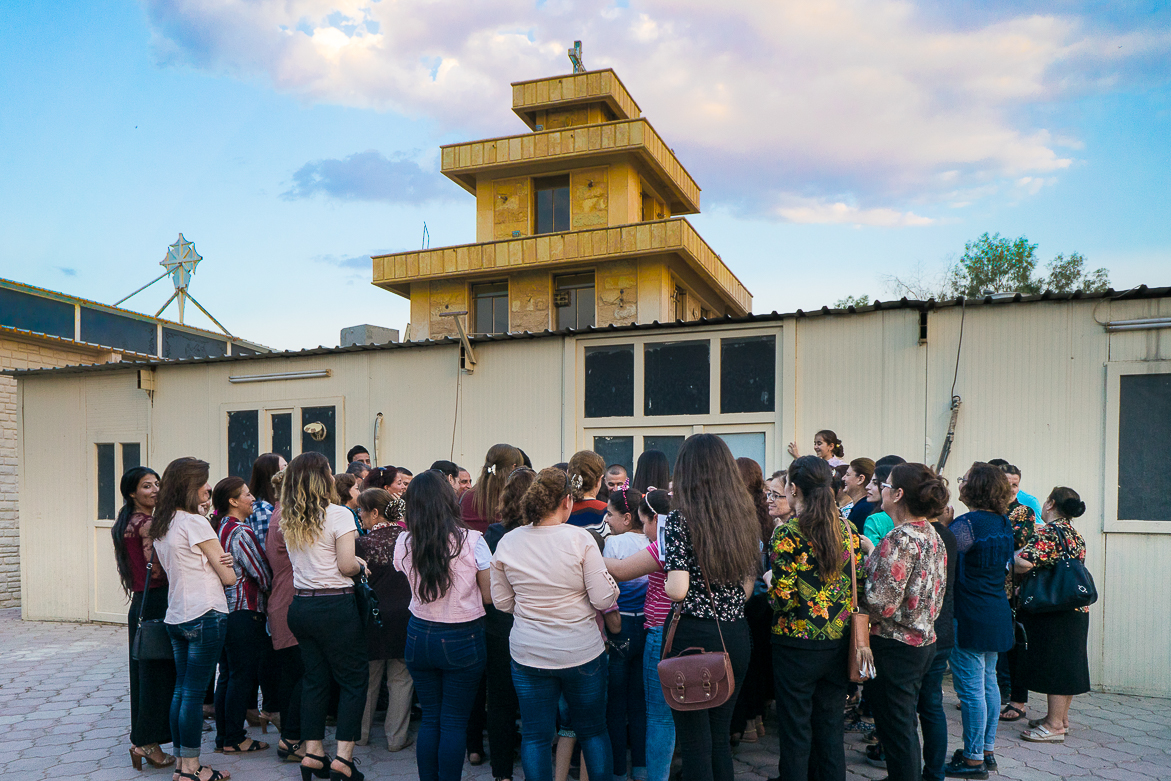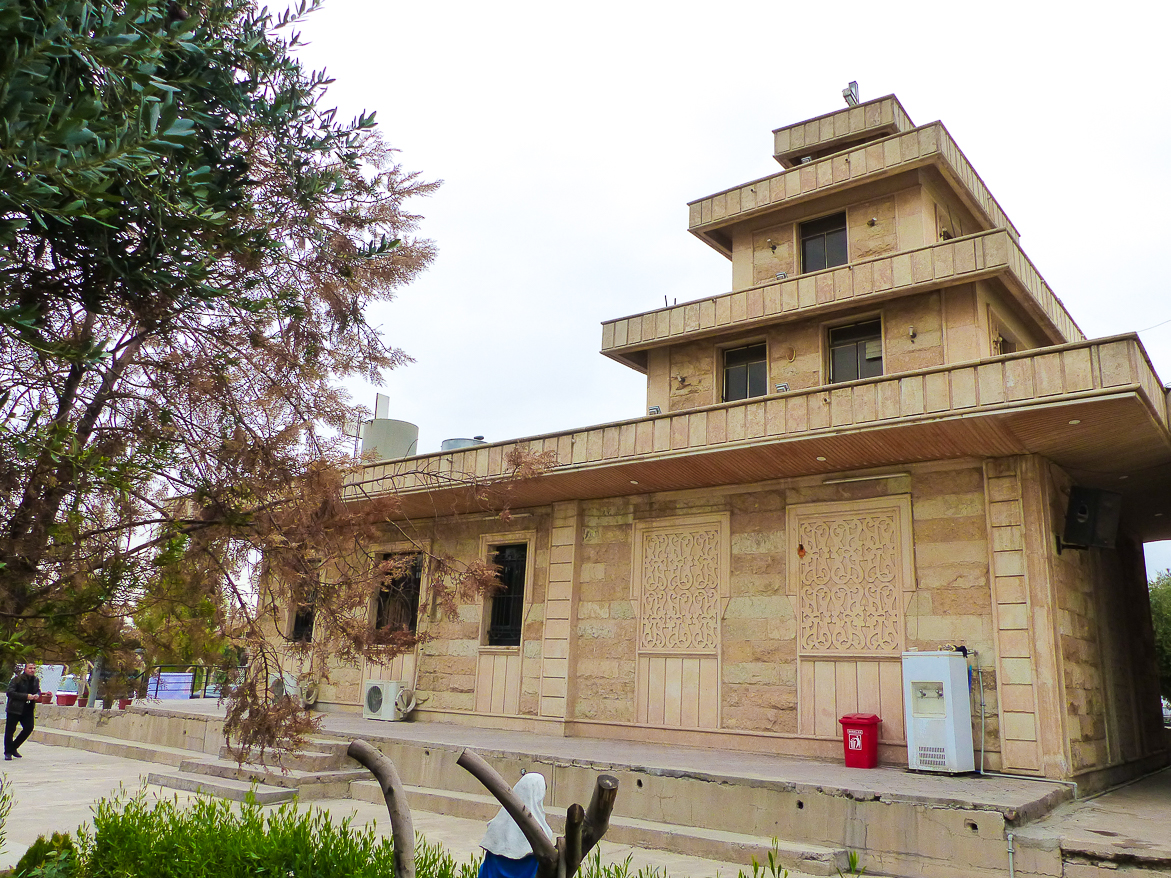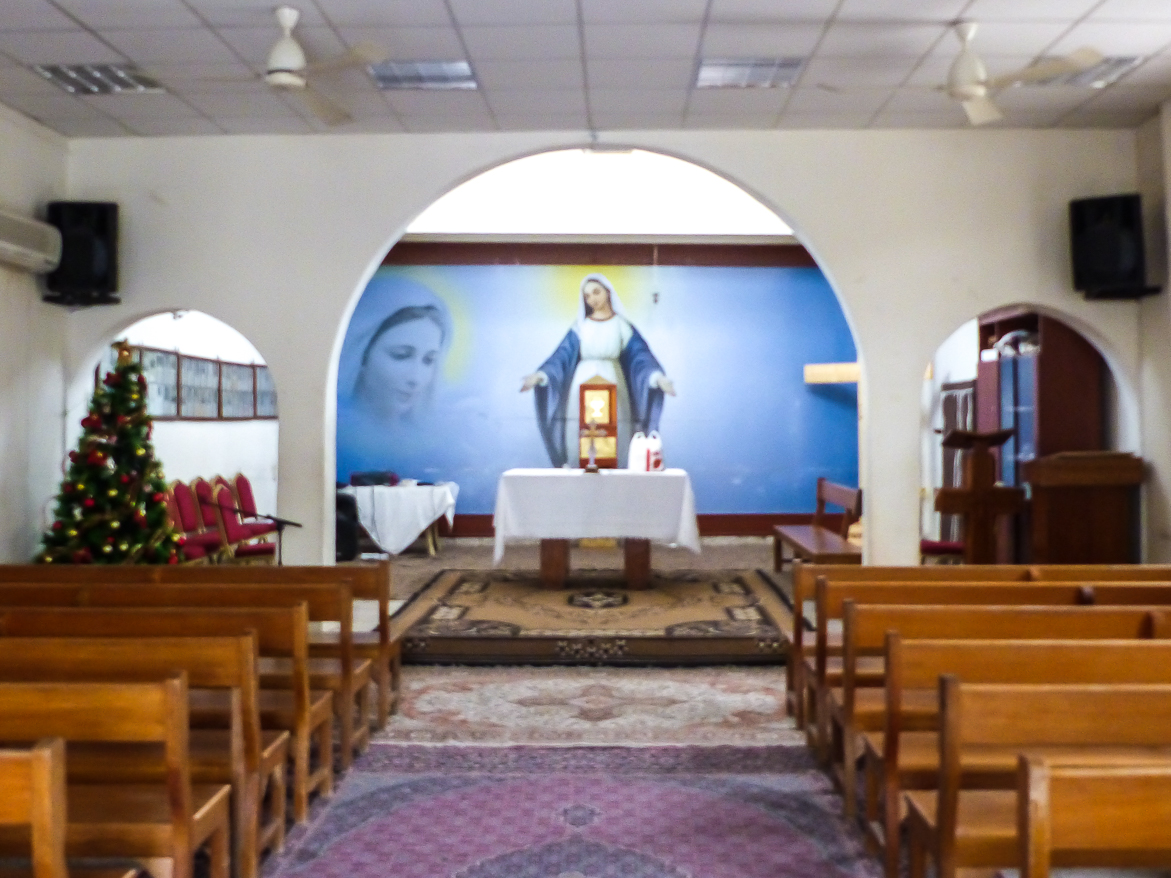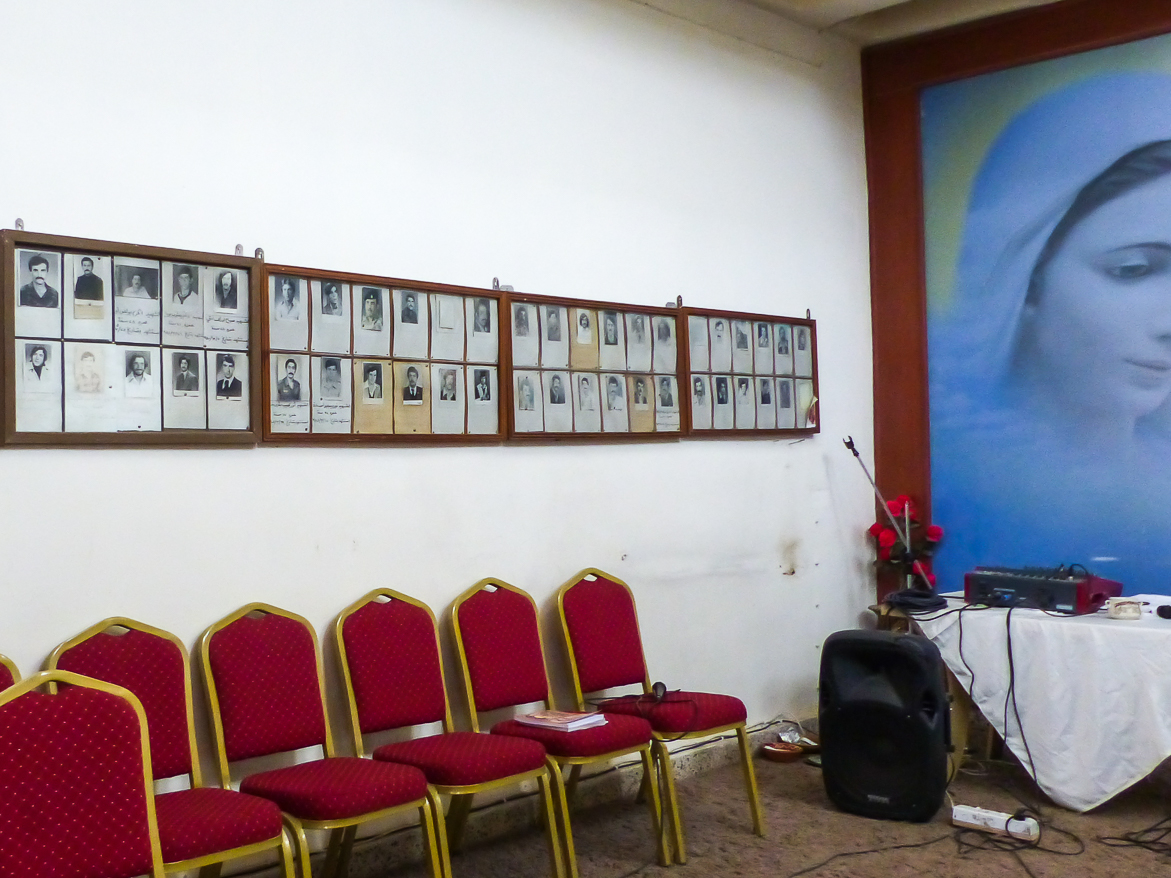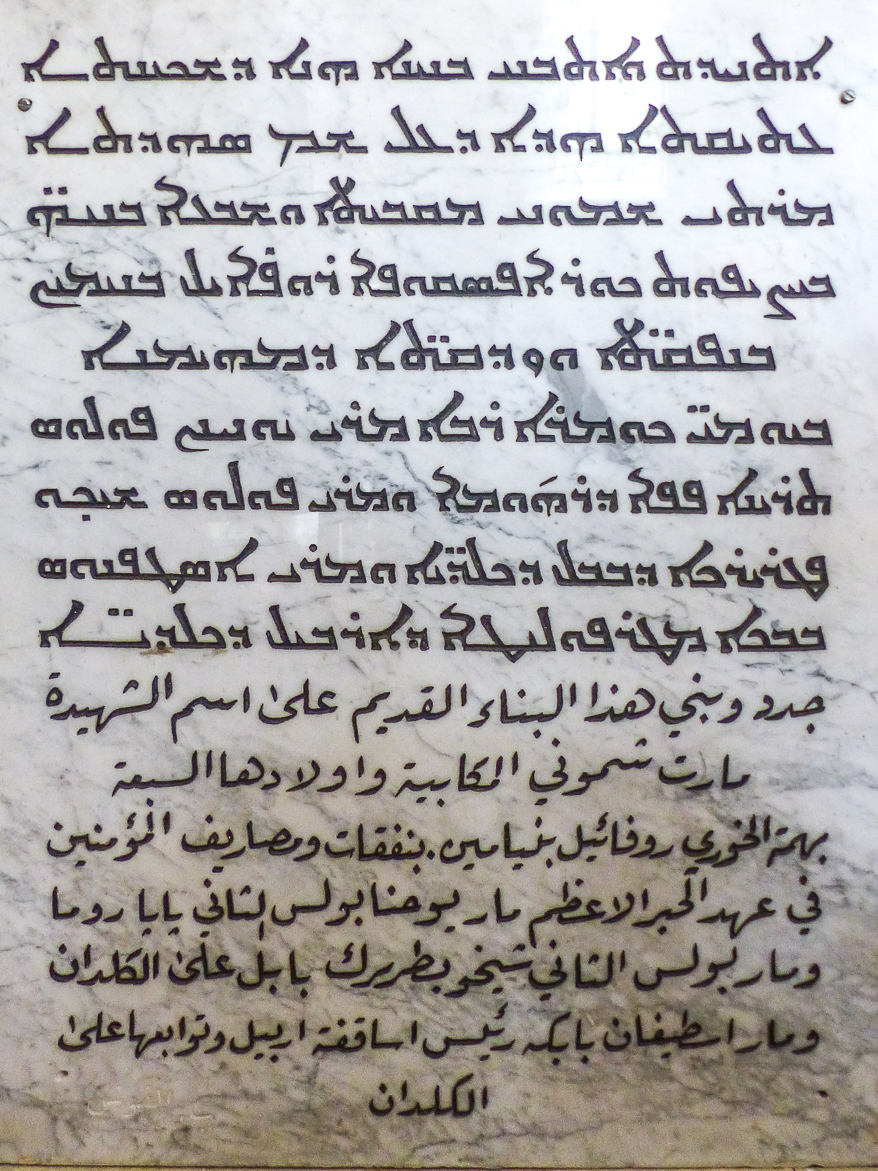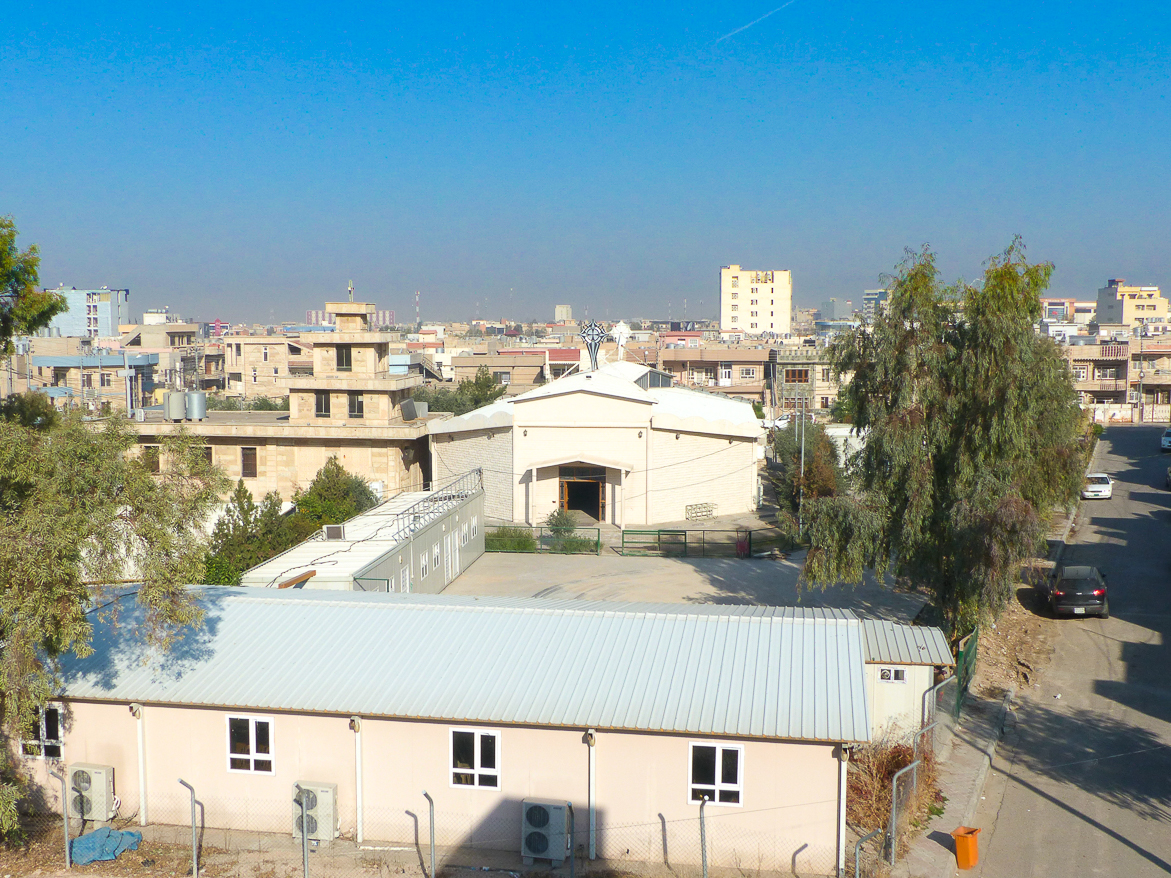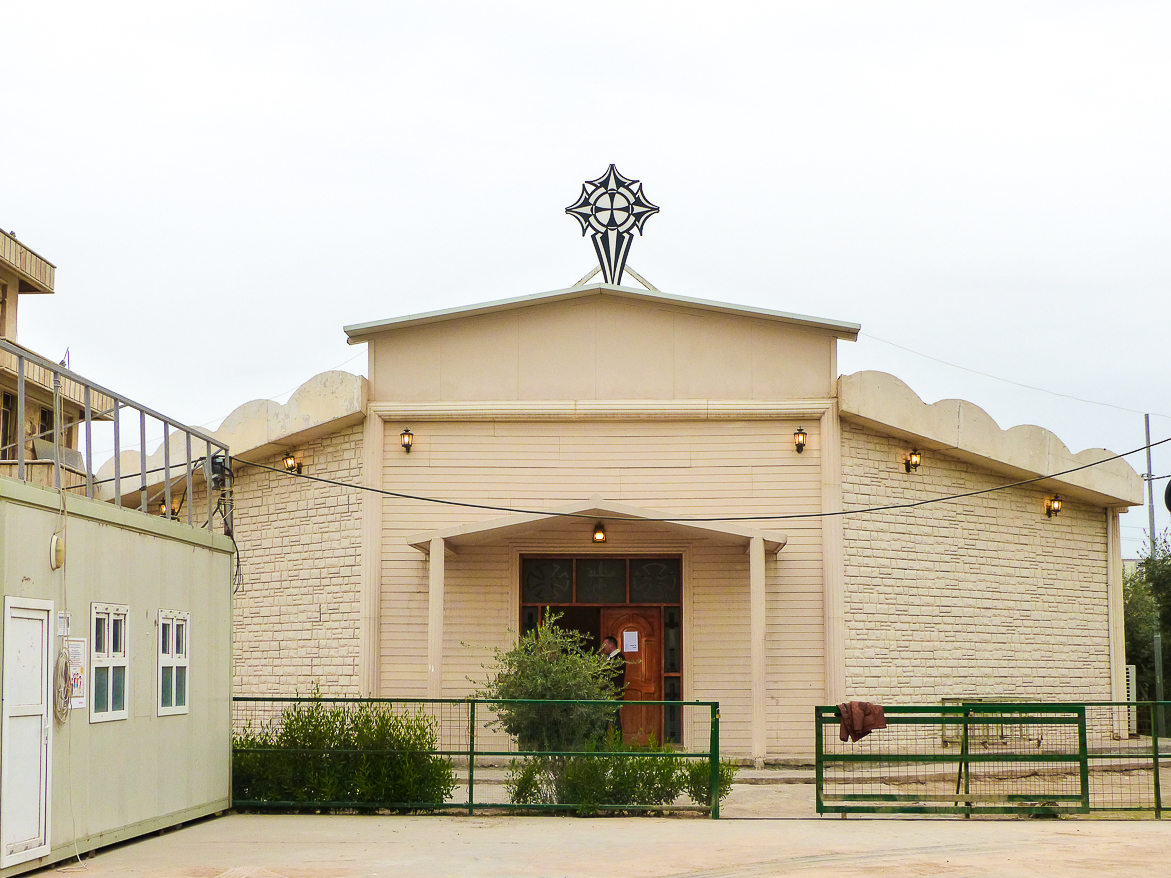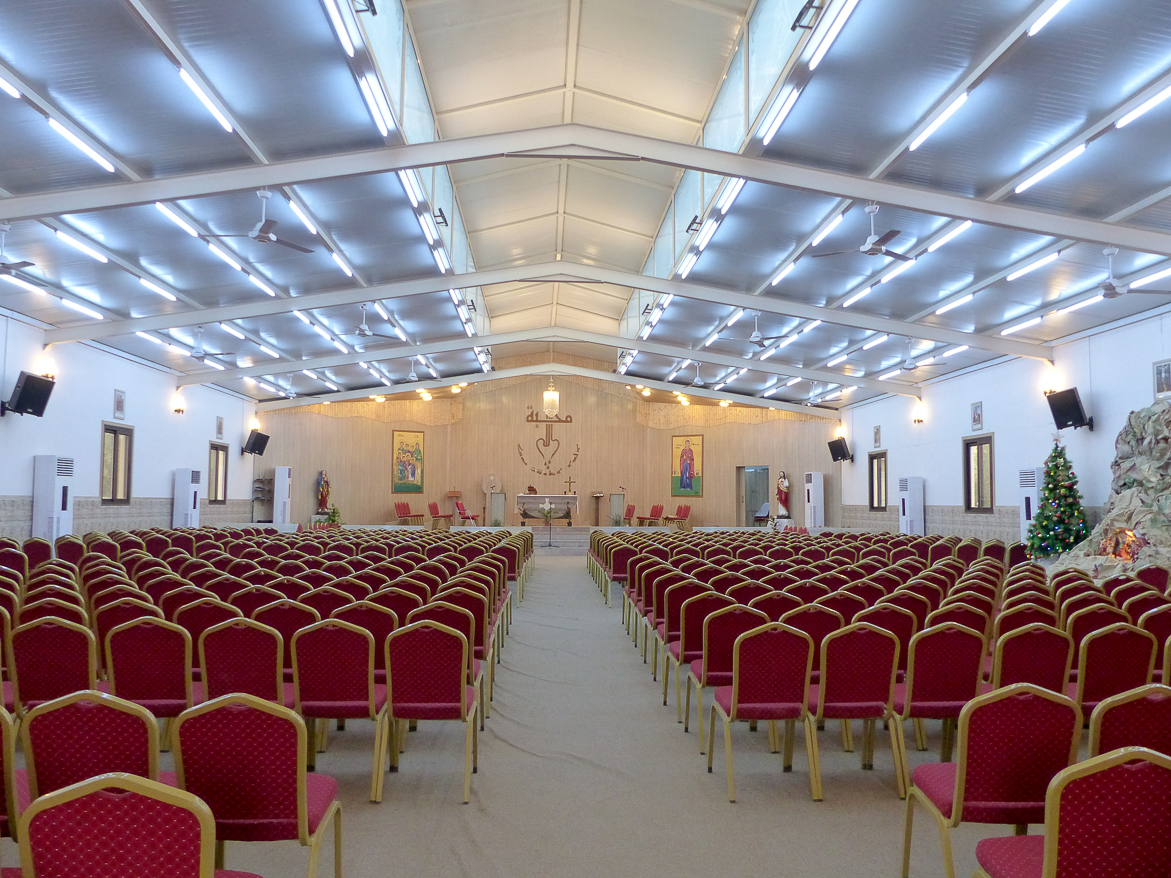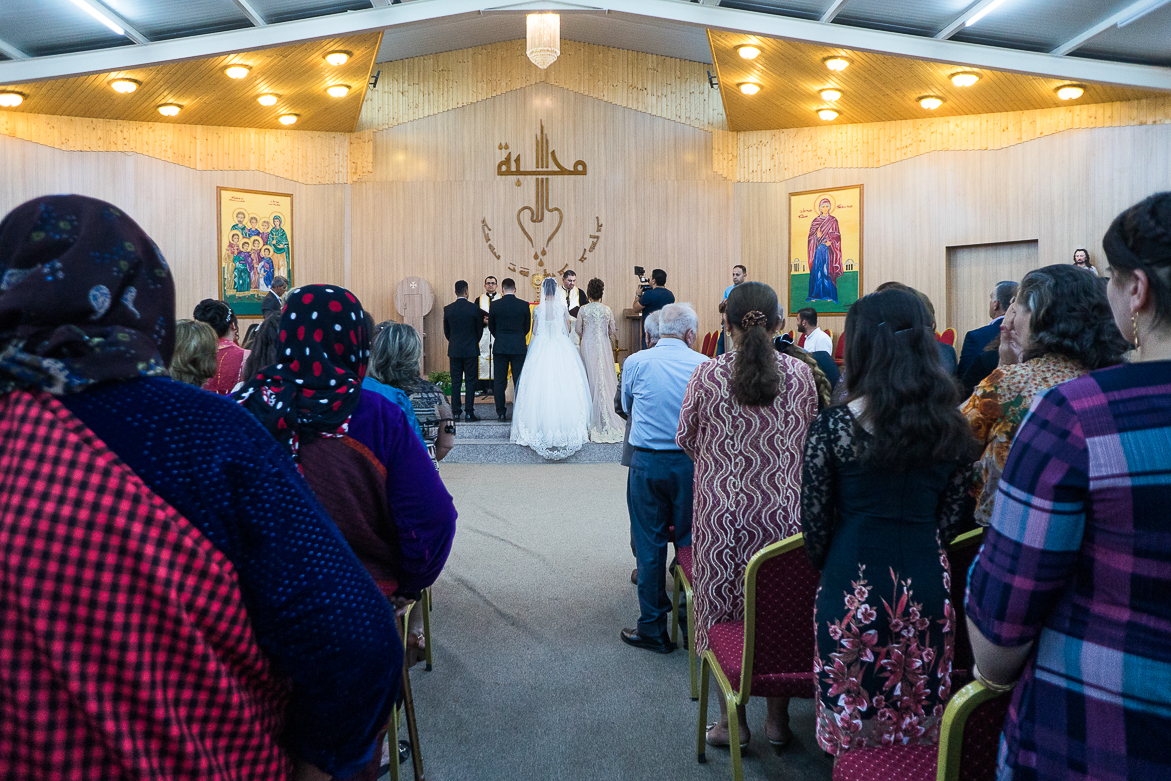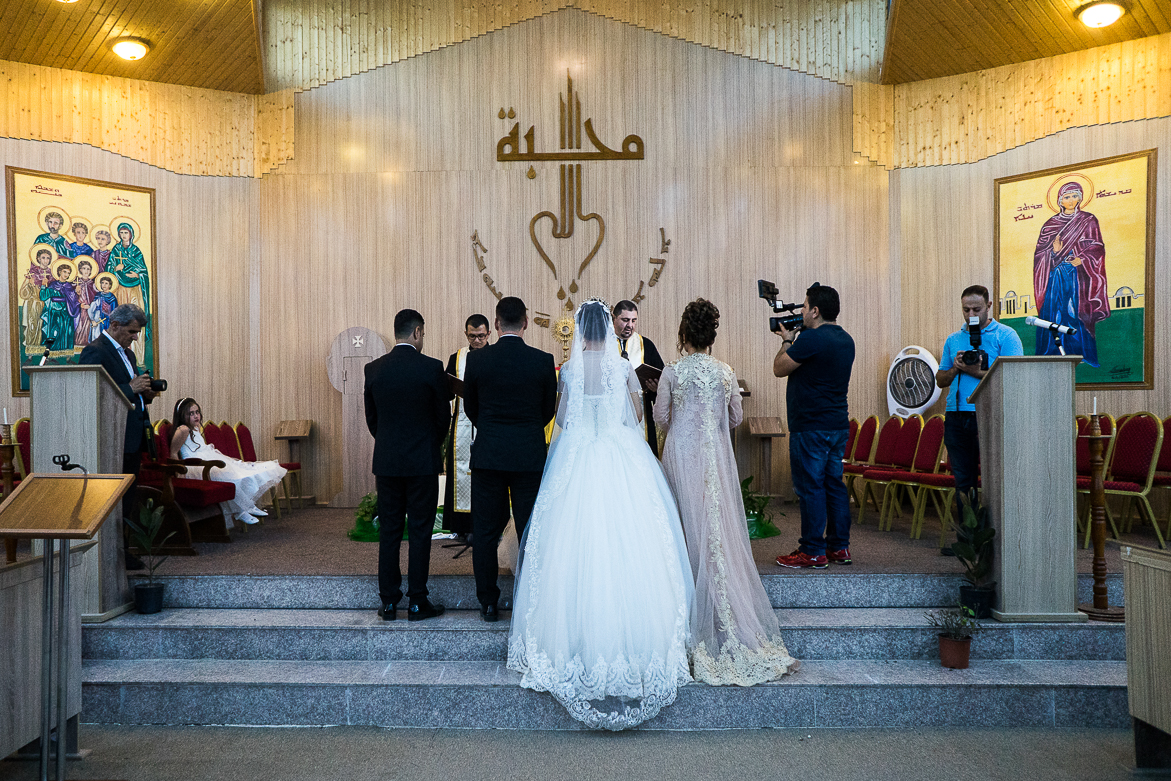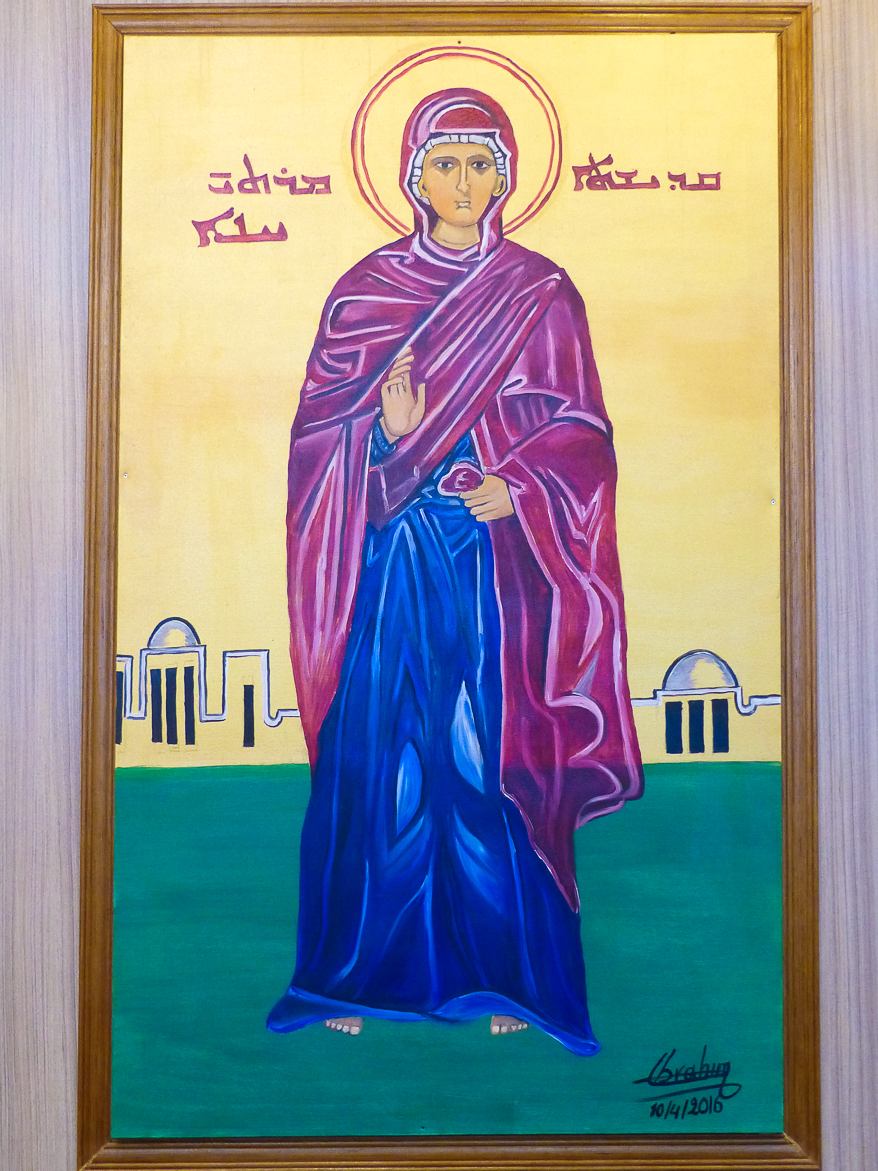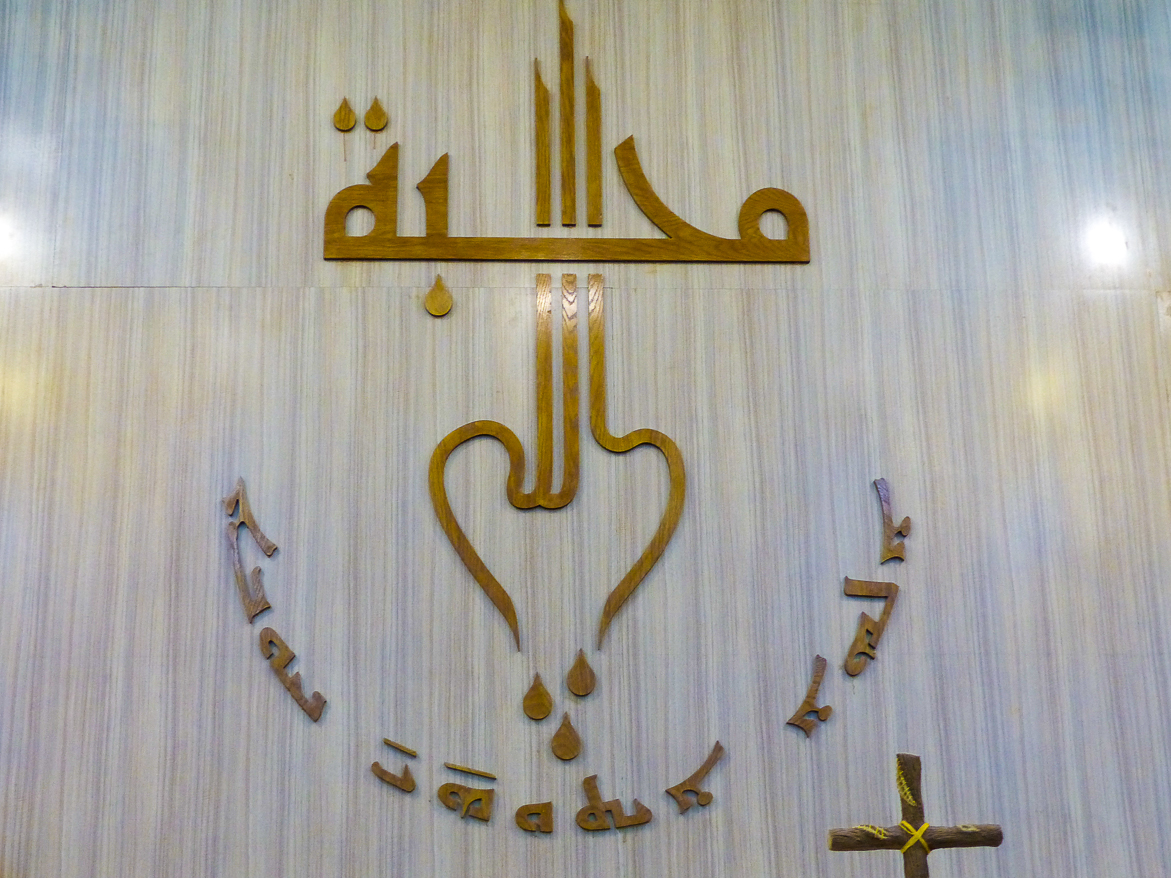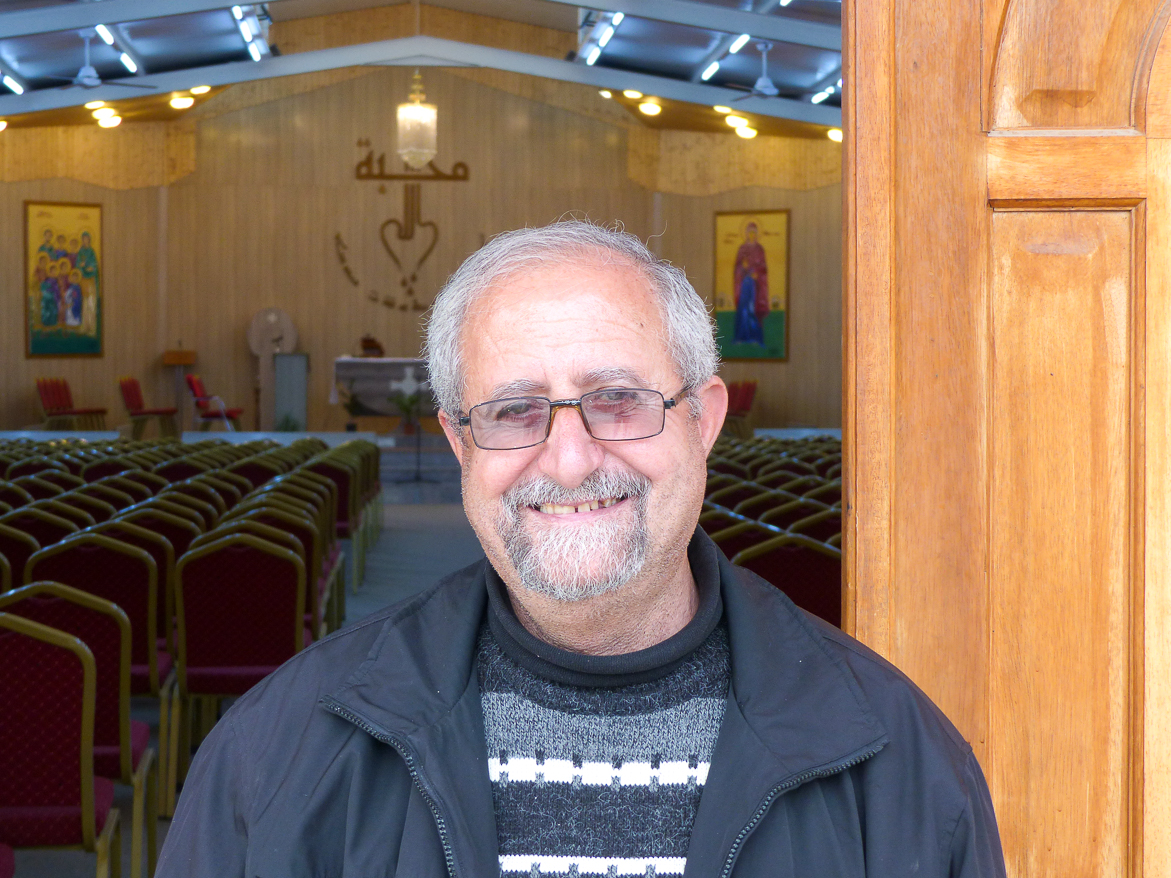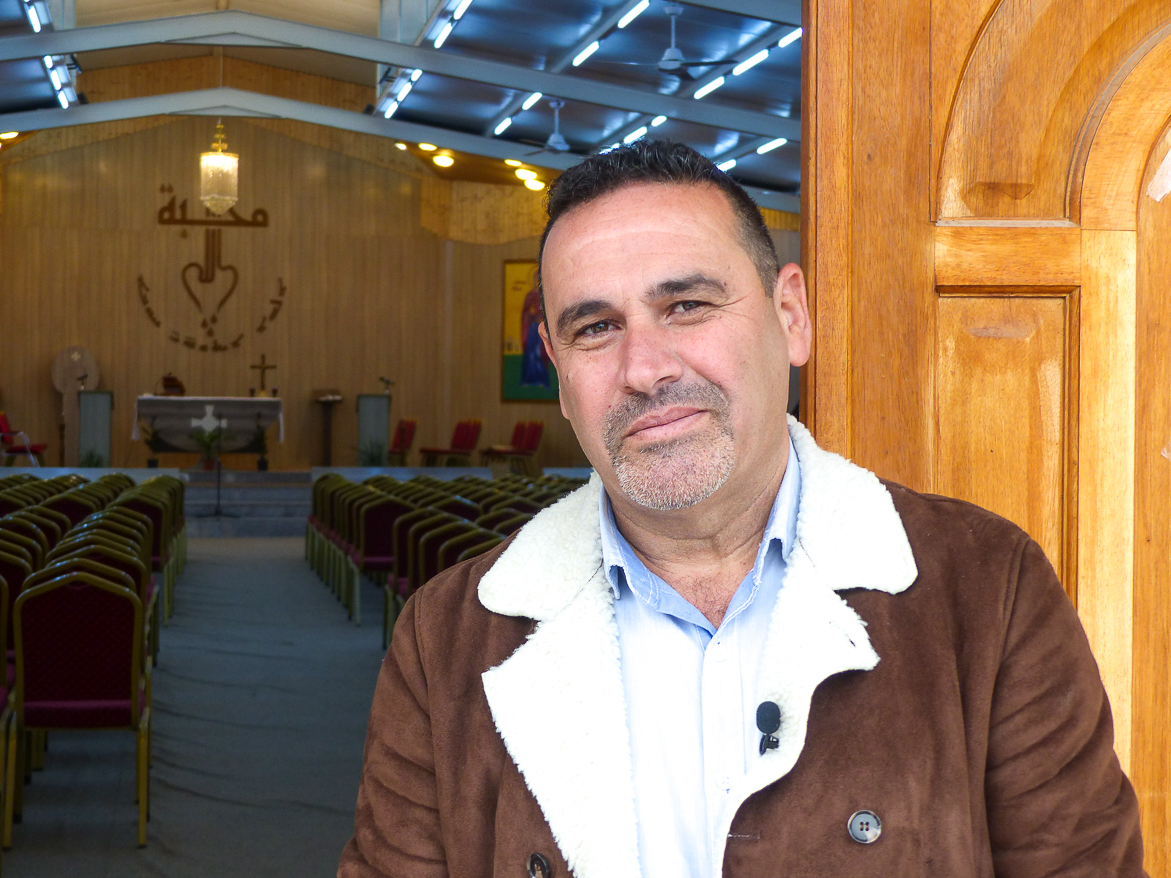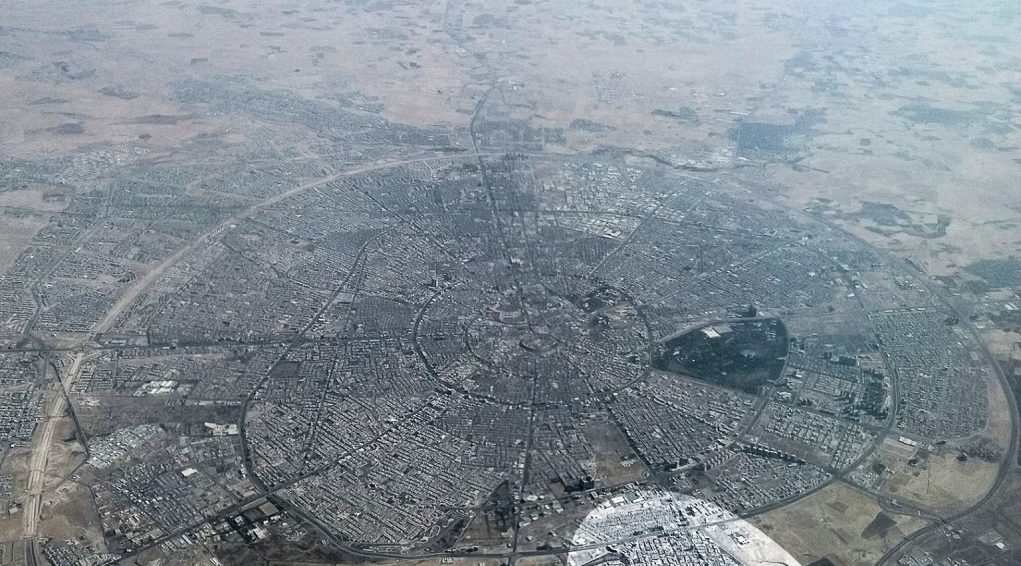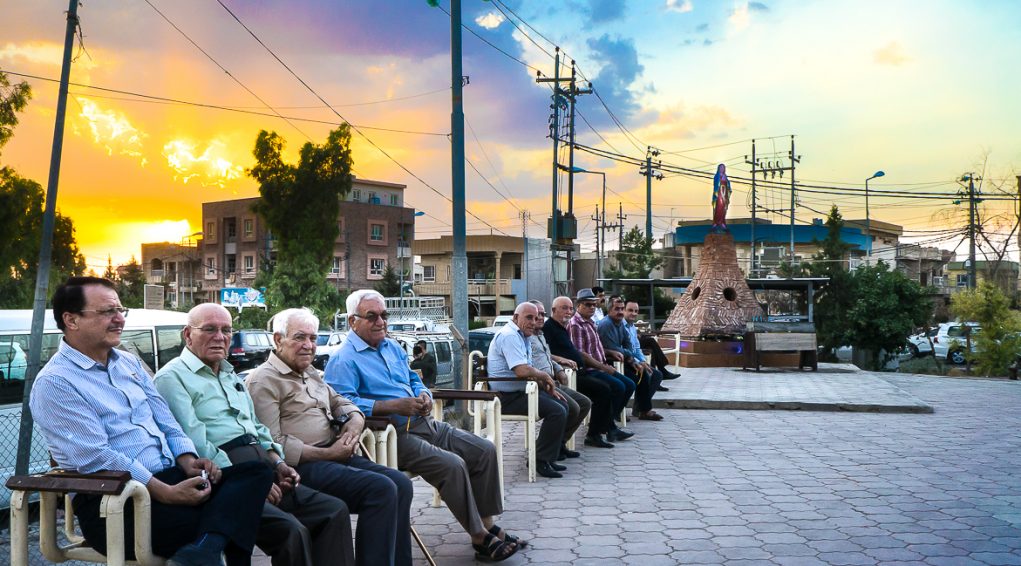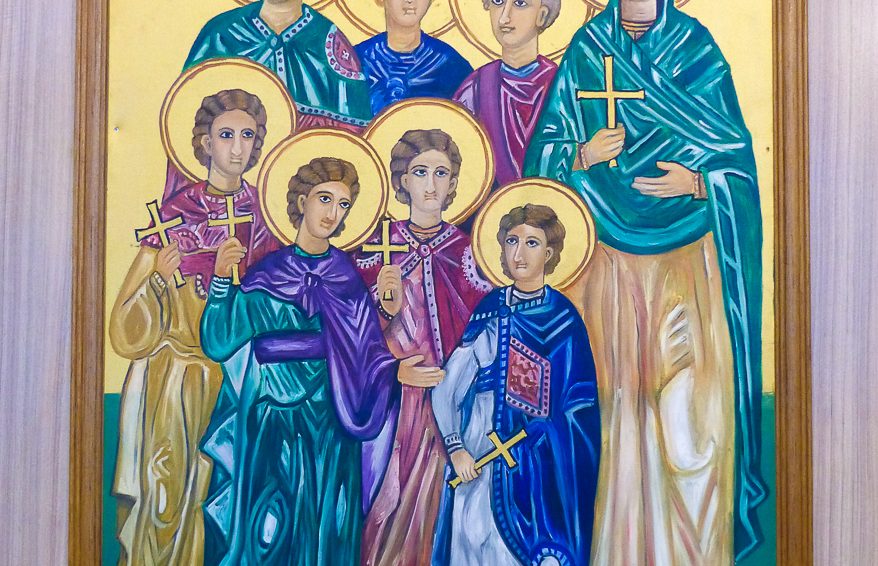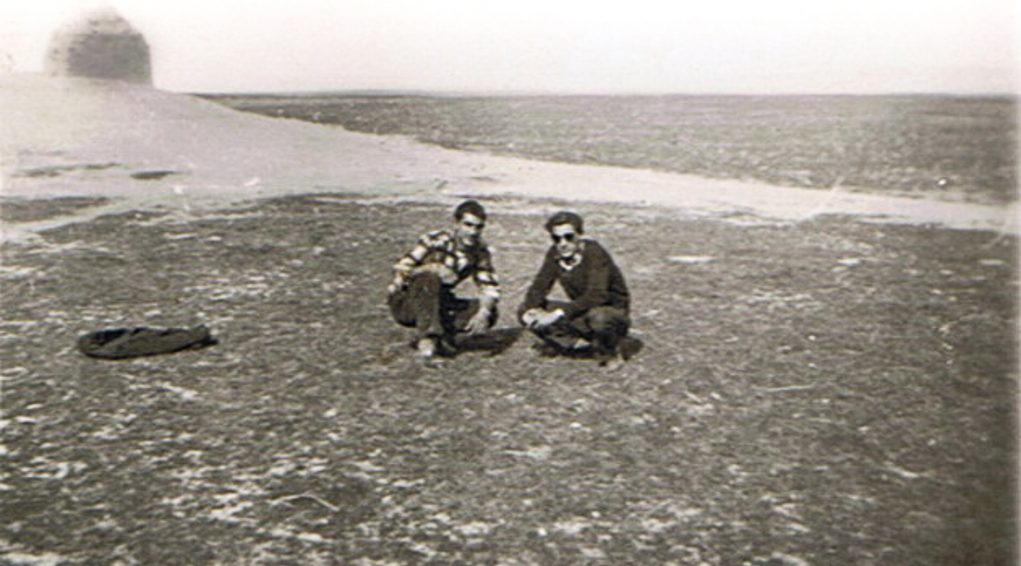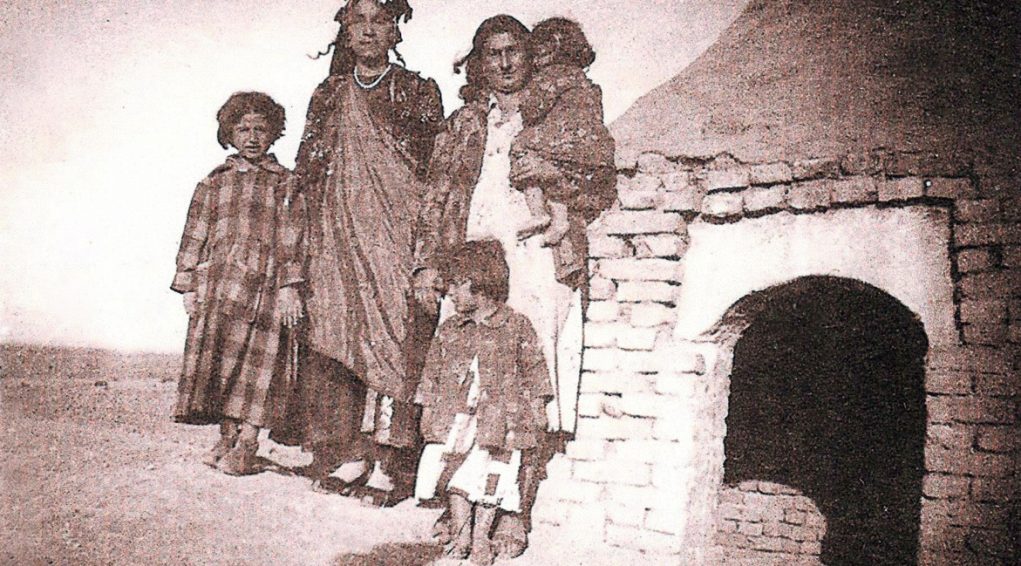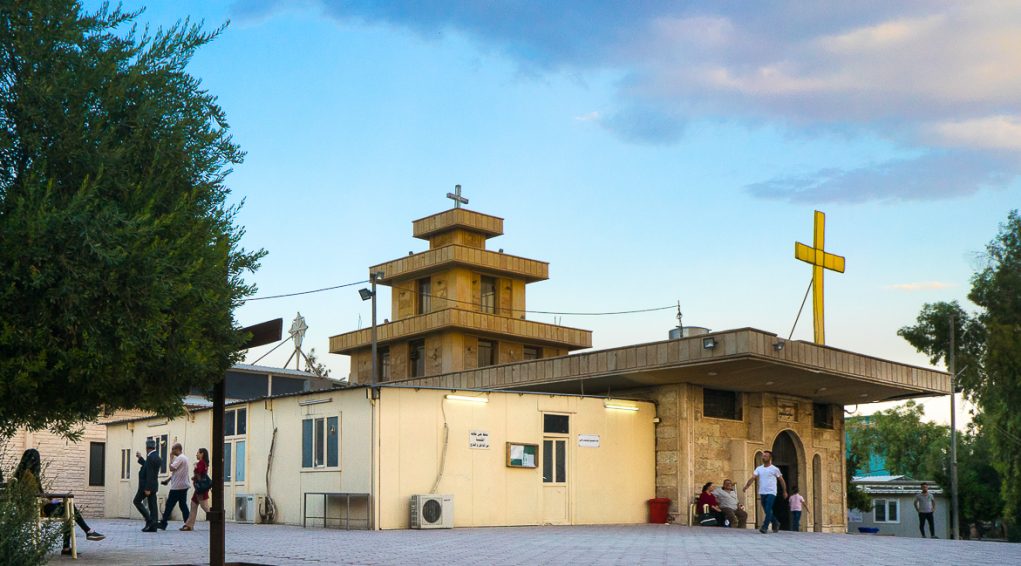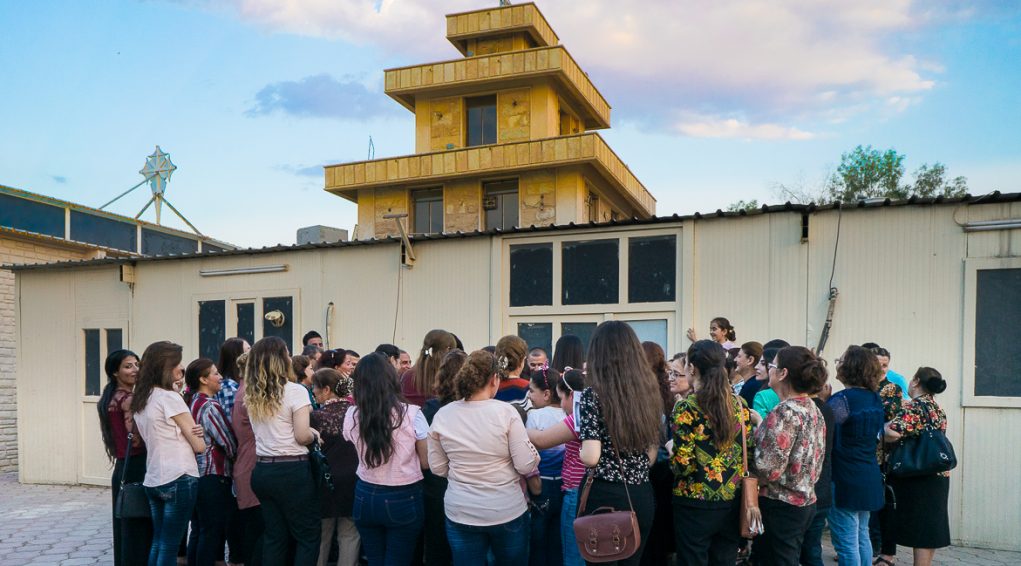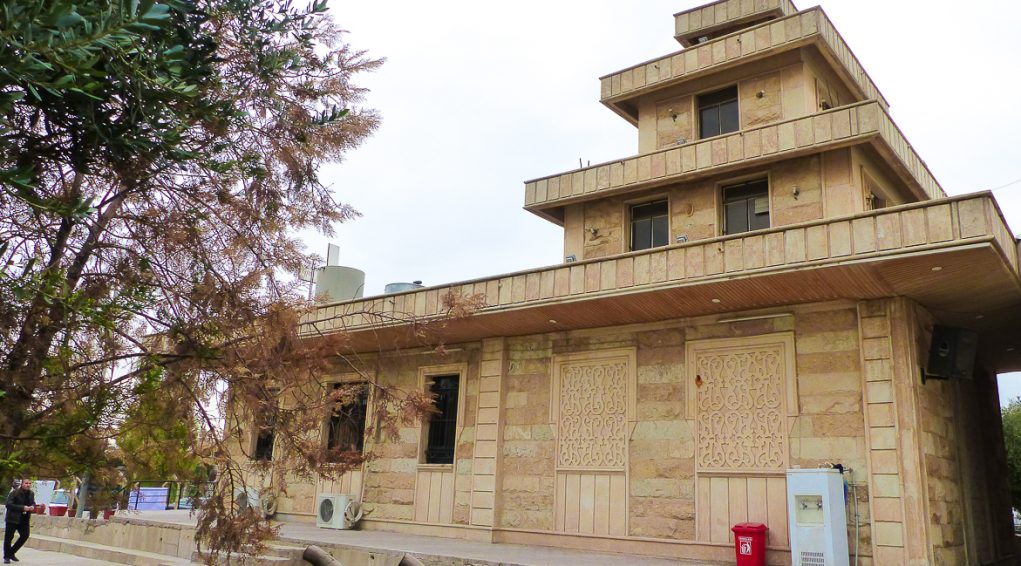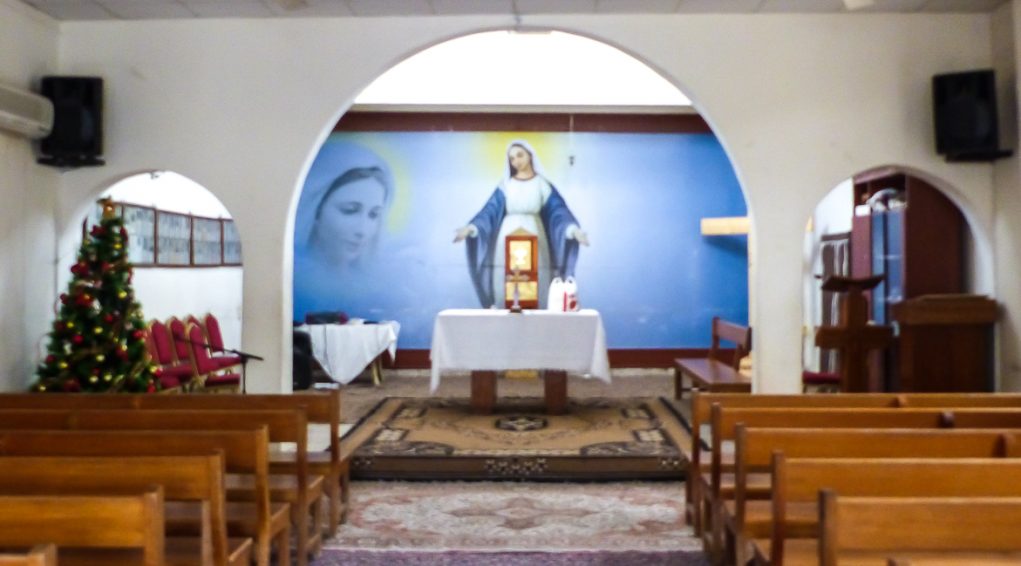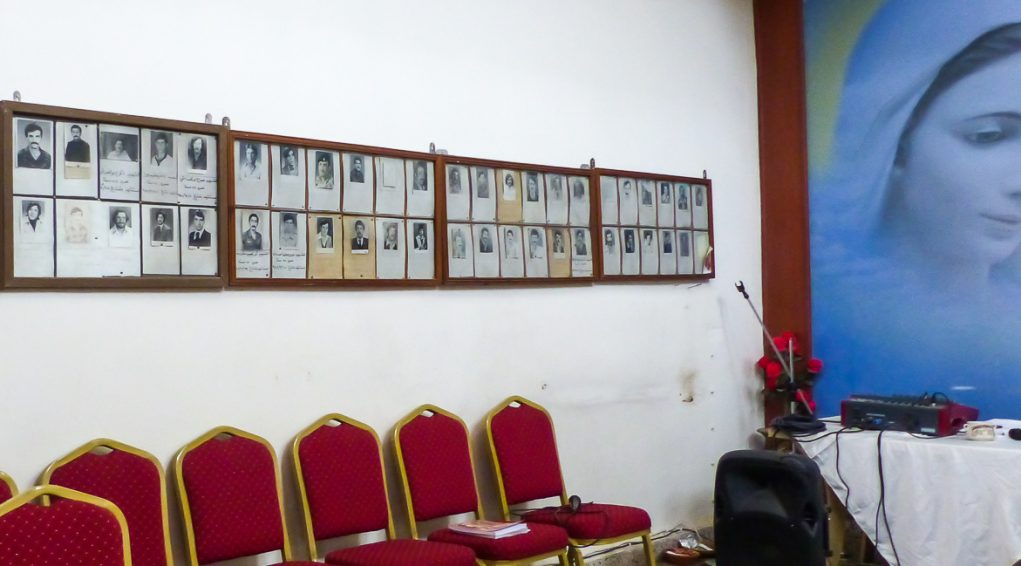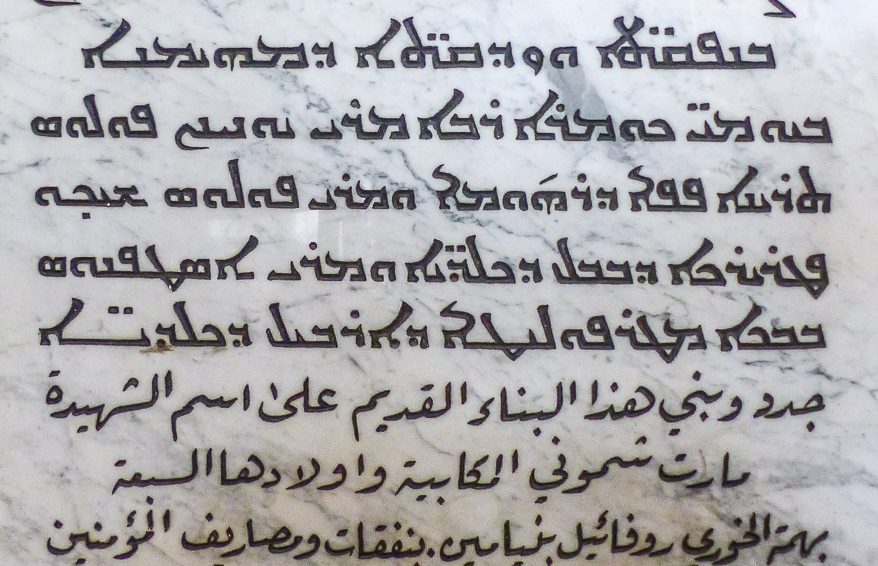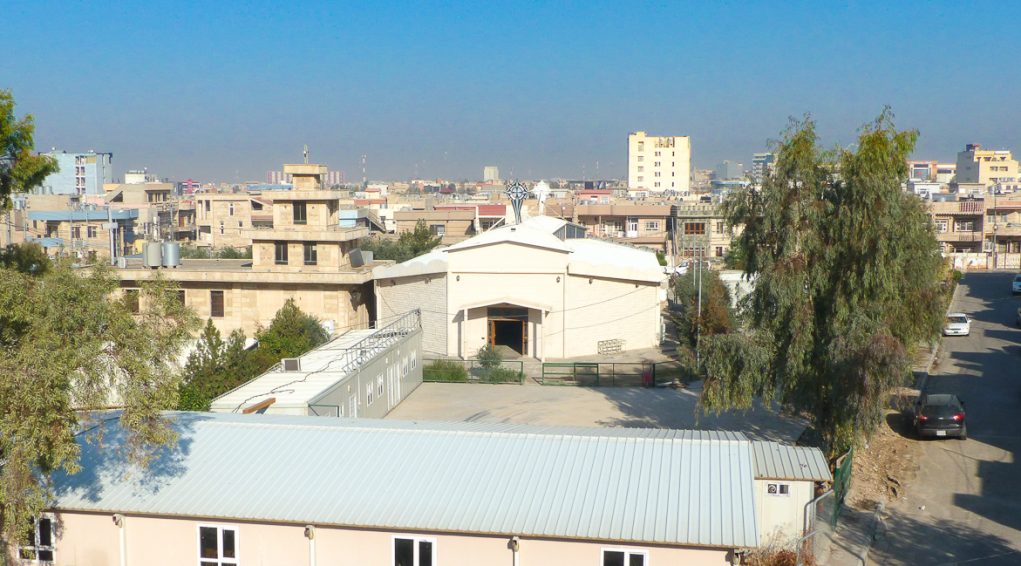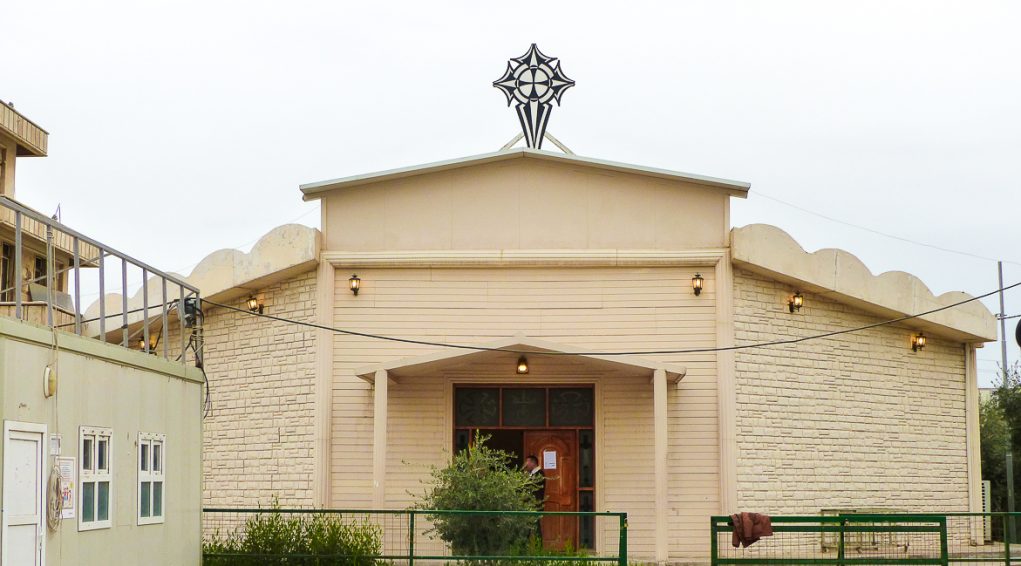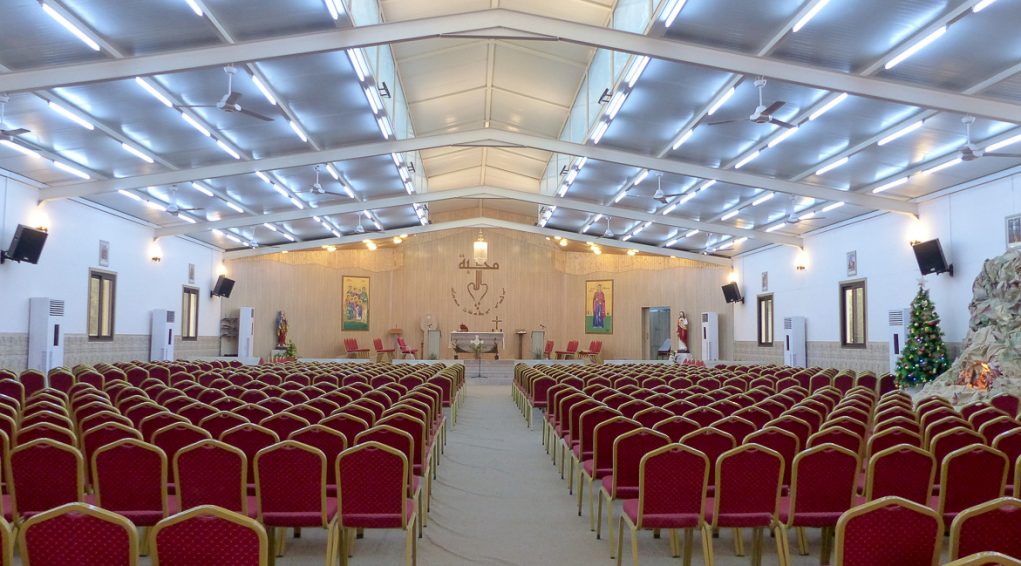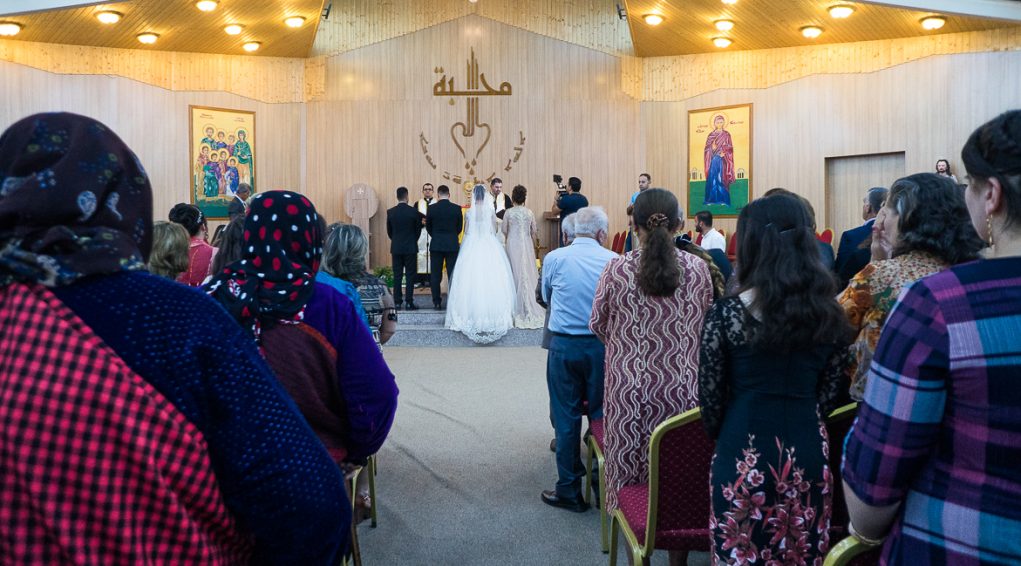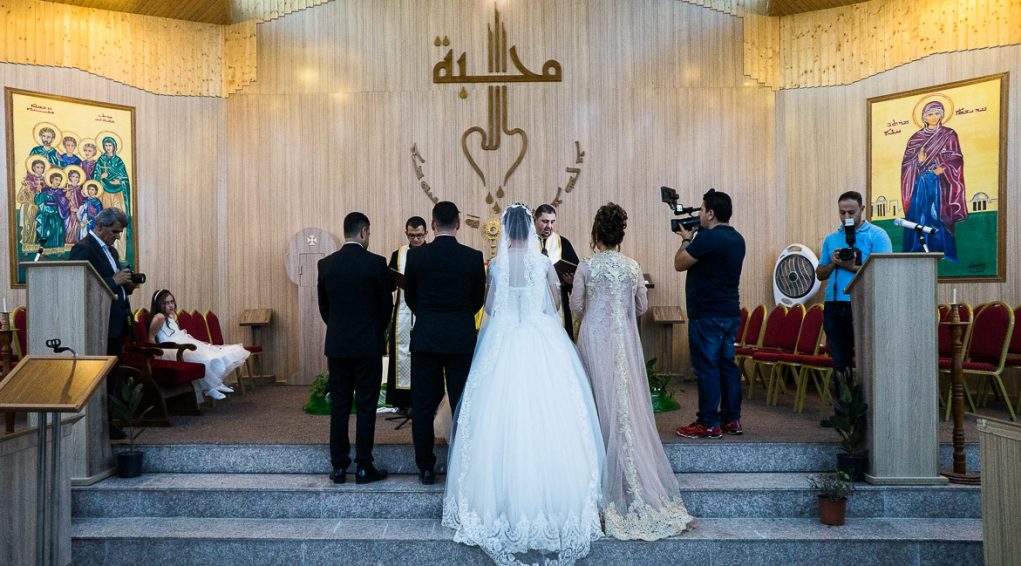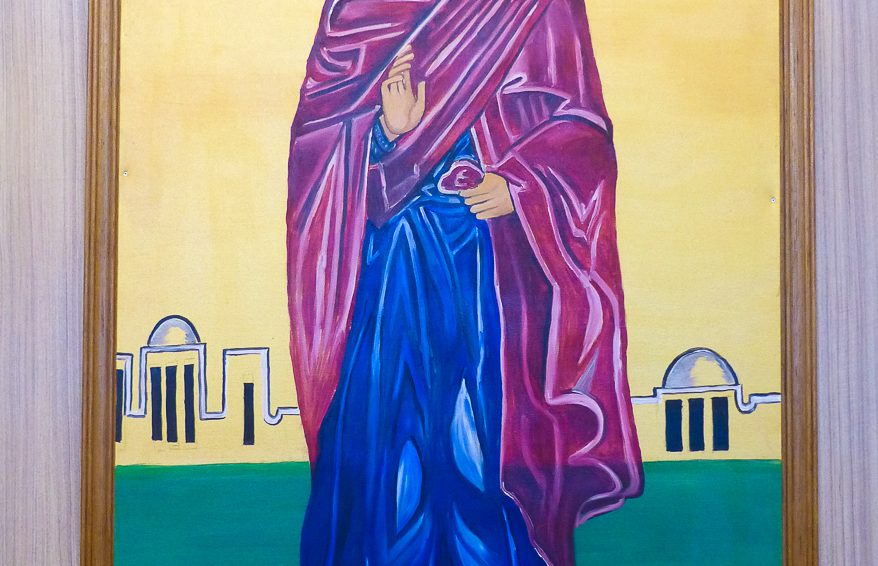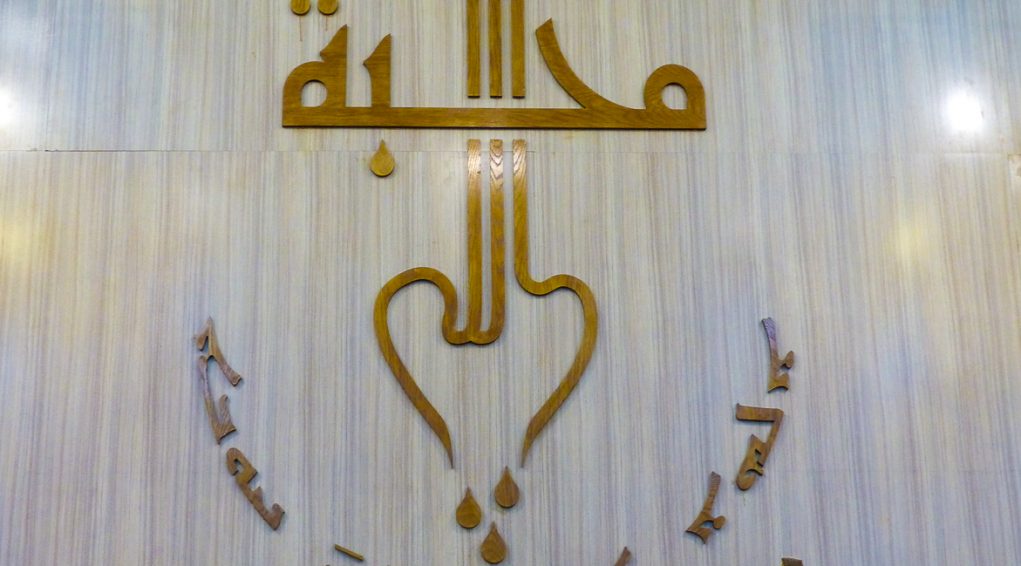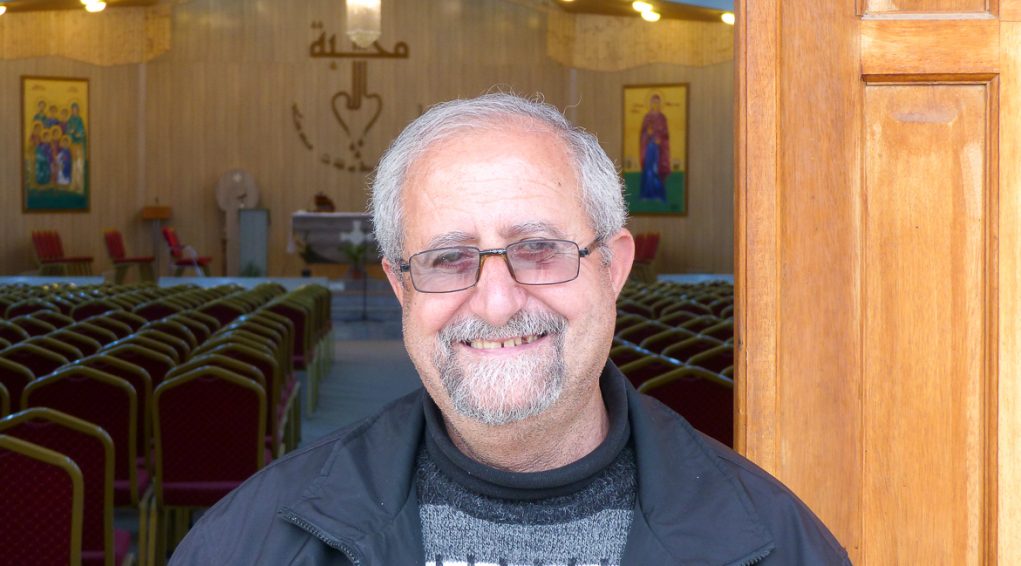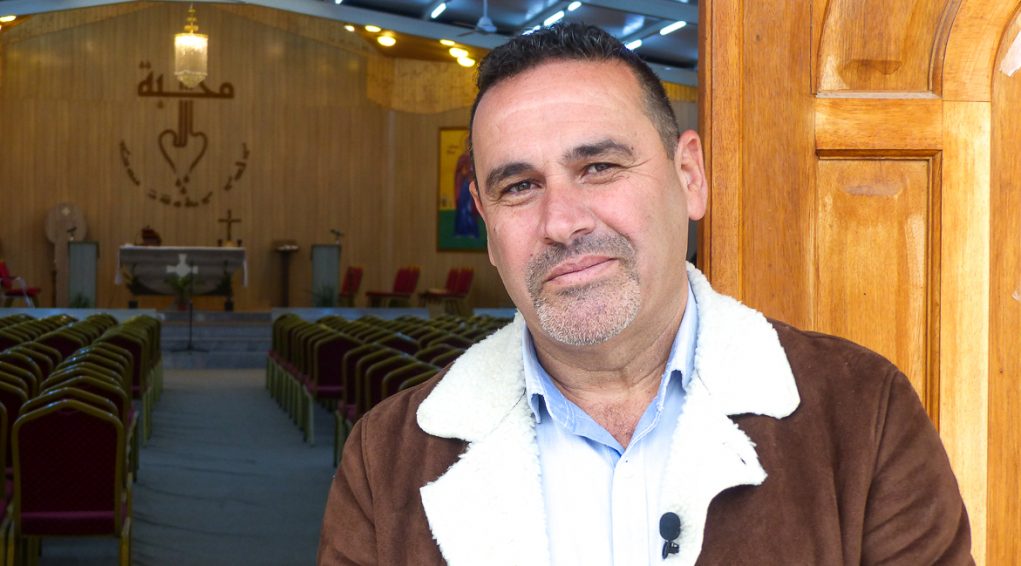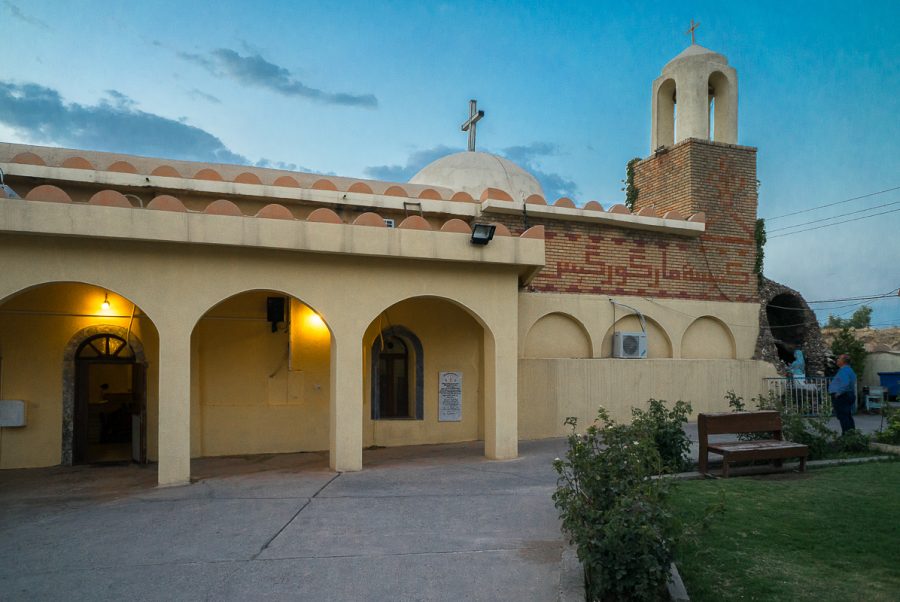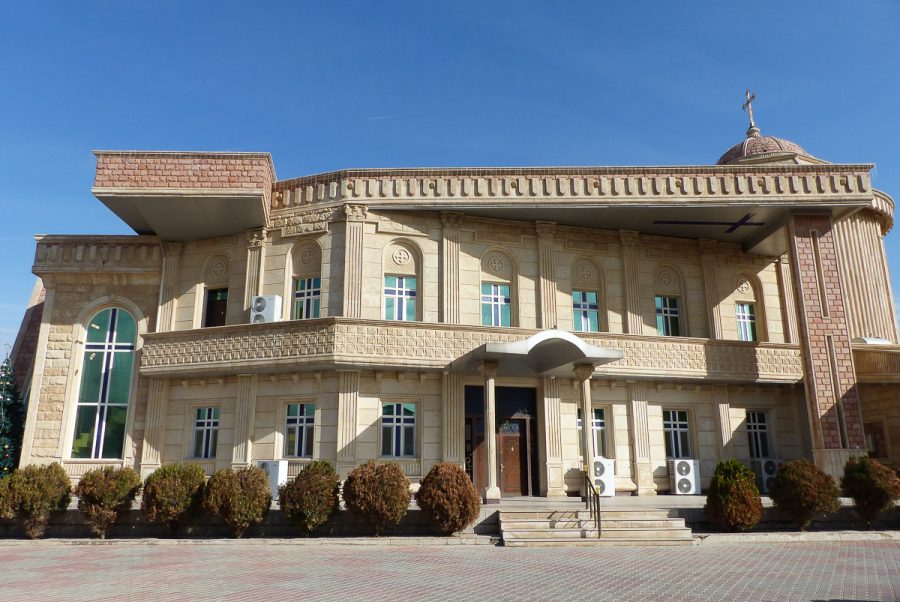Mart Shmoni Church in Ankawa
Mart Shmoni church in Ankawa lies at 36°14’5.86″N 43°59’17.50″Eand 409 metres high.
Between 2014 and 2016, Mart Shmoni was used as a refuge for thousands of displaced people from all over the Nineveh Plain.
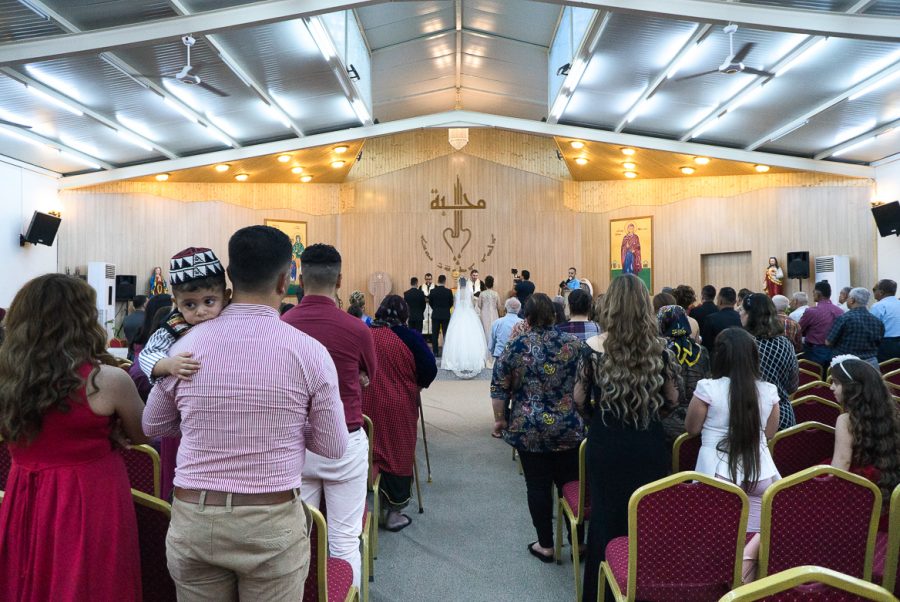
At the beginning, the site dedicated to Mart Shmoni was only supposed to be a little shrine, made of clay, with a large stone protected by a small oratory, also in clay. People came here on pilgrimage. In 1981 (or 1985), the oratory was destroyed and rebuilt as a new shrine. During this following decade, the Babylonian-styled church that is to be seen today has been erected. In 2014, a new Mart Shmoni church, just next to the old one, has been constructed for the thousands of Christian Syrian-Catholic refugees seeking refuge in Ankawa.
Location
Once situated on the outskirts of the village of Ankawa, the shrine of Mart Shmoni has progressiveley turned to a great religious compound, in the very heart of the town, 36°14’5.86″N 43°59’17.50″E and 409 metres high.
Ankawa is now a district of the great metropolitan area of Erbil[1]. As capital city of the autonomous Kurdistan Region in Iraq, Erbil counts today 1.5 million inhabitants. It lies in the plain, 30 km east from the Great Zab, an affluent of the Tigris River, 80 km east from Mosul and 25 km south from the southern border shaped by the Kurdish mountain.
Fragments of Christian history
Erbil, also referred to as the antique Assyrian city of Arbeles, is quite close from the presumed place of the plain of Gaugamela, where the famous battle took place, offering Alexander the Great a large victory on the Persian Darius III in 331 BC. Former capital city of the Assyrian kingdom of Adiabene, a kingdom that used to be shunted from the Parthian, to the Roman or to the Armenian empires, the area is famous for being in the 1stcentury one of the Jewish community in Mesopotamia that the Christians undoubtedly tried to convert to Christianity. “We have no sources regarding the circles that were concerned with evangelization; however it seems sensible to think that the first ones to convert were taken among Jewish population, very important in those times throughout Mesopotamia, and even beyond the Tigris River, from the days they had been deported to Babylonia by Nebuchadnezzar. Most probable is the fact that the greatest efforts to convert people were focused on these Jewish communities, as it already was the case in all cities of the Roman Empire[1]”. And here again, the first steps of this evangelization’s process were linked to the missions of the apostles Thaddeus, Bartholomew and most of all Thomas and their disciples. The tradition reports that Thomas “made a halt in Selusia-Ctesiphon on his way towards India[2]”.
At the very beginning of the 4thcentury, the area of Abadiene, which was then the most southern territory of the kingdom of Armenia, has gone through a new evangelization’s phase, after Armenia became the very first Christian “state” in History, around 301.
«What also seems reliable is that there has been a meeting, around 328-329, between the only two Christian sovereigns in those times: the Roman emperor, Constantine the Great, and Tiridates III of Armenia. Constantine the Great confirmed Tiridates’ role in evangelizing the East. That is the reason why Armenian missionaries took part in evangelizing Mesopotamia and the Sasanid Empire, as related by the Greek historian Sozomen around 402: “Then, among the border people, the faith grew and worshippers increased in number and I do think that the Persians turned to Christianity thanks to the important relationships they had with the Osroenians and the Armenians[3](…)”». The Christian city of Erbil was made episcopal see, and met with Islam with the Muslim conquest and the Abasid caliphate from the end of the 7thcentury on, thus paving the way to the whole area’s islamisation, which never ceased until today, whoever were the conquerers: Seljuqs, Mongols, Persians, Atabegs, Ottomans or Kurds.
At the very beginning, the Christians from Erbil and Ankawa were members of the Apostle Assyrian Church of the East but they progressively turned to the Chaldean Catholic Church, and this mainly ran through the 18thcentury. And just like the people, the buildings and architectural heritage was transferred from one Church to the other.
In the last quarter of the 19thcentury, the French Dominican missionary Jacques Rhétoré while passing through Erbil wrote that “apart from a few Jewish families, the whole population is Muslim and can number 12 to 15 000 people. (…) Not a single Christian lives in Ervil, whereas there used to be a lot of them in this city, which used to be a place of residence of a Catholic bishop. The Christian population has been persecuted and humiliated in this town for ages, and henceforth left it to settle not far from here, in a place which is today the Chaldean village of Ainkawa (…). Six priests lead today this community of around 250 families”.[4]
[1]In Histoire de l’Église de l’Orient, Raymond le Coz, published by Éditions du Cerf, 1995, p.22
[3]In Arménie, un atlas historique,p.22 and map p.23. Publisher Sources d’Arménie, 2017.
[4]In Voyage d’un missionnaire dans les provinces de Kerkouk et de Solimanié de l’empire turc ,Année dominicaine, 1879. P. 492-493.
Fragments of hagiography
The hagiography of Mart Shmoni and her seven saint children is very well known throughout all the Christian East in Mesopotamia. The story of this Jewish family is related in chapter 7, from the second Book of the Maccabees. It reveals how the Jewish were persecuted under the reign of the Seleucid king Antiochus IV Epiphanes, because they respected the Laws of God and and already believed in resurrection and eternal life… two centuries before the advent of Christianity.
The seven Maccabees brothers were then “arrested with their mother and forced to eat pork[1]” in order to abjure their faith. All refused and were sentenced to death and killed, one after the other, under their mother’s eyes. The first one was then “horribly tortured, then fried alive in a pan[2](…)”. Despite her great distress, their mother, Mart Shmoni, encouraged them, one after the other, to remain faithful to the Law of God, until the very last, begging him not to fear the torturer and to “be up to your brothers, accept your death, so that I can come and join you all in mercy.”[3]
[1]In La Bible rendue à l’histoire, Jean Potin, Publisher Le Club, Juin 2000, p.616
A shrine before to be a church
Originally, the site dedicated to Mart Shmoni was only supposed to be a little shrine, made of clay, with a large stone protected by a small oratory, also in clay. People came here on pilgrimage, lit candles and practised their devotion. Jean-Maurice Fiey mentions however “that the vestiges of both churches known as Mart Šmūni and Mart Mariam are still to be seen in the surroundings of Ainkawa[1]”.In 1981 (or 1985), the oratory was « replaced » and rebuilt as a new “shrine” made in bricks. During the following decade, the Babylonian-styled church that is to be seen today has been erected.
From the outside, the structure of Mart Shmoni church in Ankawa looks like a stepped pyramid. Inside, the architecture shows nothing particularly noticeable. The most significant part is the apse: behind the high altar, whose far wall is adorned with a huge fresco dedicated to the Virgin Mary[2].
[1]In Assyrie Chrétienne, vol. I, Imprimerie catholique Beyrouth, 1965-1968, p.172
The modern days and the new Mart Shmoni church
At the beginning of the 21st century and as if rewriting History, Erbil has regained its influence as a major Christian centre. The city of Ankawa, north of the city, has indeed welcomed tens of thousands of Christians from Baghdad, Mosul, from the Nineveh plain or from Basra, all fleeing anti-Christians persecutions from Islamic and/or mafia groups that thrived since the United States invaded Iraq in 2003. The refugee policy to welcome Iraqi Christians in the Kurdish part of northern Iraq, implemented by the president of the autonomousKurdish regions in northern Iraq, Massoud Barzani, is clearly perceptible in Erbil-Ankawa. Besides refugee camps for Christians and Yazidis, new and large churches for all denominations have been constructed, including the new Mart Shmoni church and thousands of Christian families have settled for good in the town. Many schools and medical centres, all run by various Churches, have been built and the Babel College has even been transferred from Baghdad… These varied and multiple initiatives strengthen the Christian vitality of Ankawa. The twinning between the Archbishoprics of Lyon (France) and Mosul is one of the most fruitful examples of this revival. This twinning aims at offering material, moral and spiritual support. It had been created and announced on July 28thand 29th2014 by Cardinal-Archbishop of Lyon Philippe Barbarin, during his visit in the Syriac-Catholic church of Al Tahira in Baghdede (Qaraqosh) as well as in the Chaldean cathedral Mar Yousif in Erbil, in the presence of the Syriac-Catholic Archbishop of Mosul, Mgr Youhana Boutros Moshe, and of the Chaldean Catholic Patriarch of Babylon, Mgr Louis-Raphael I Sako[1].
At the turn of the third millennium, around 2005-2006, the Chaldean Mart Shmoni church has been lent to the Syrian-Catholic community to answer the spiritual needs of many people, who had to flee the chaos in Baghdad and Mosul after the US invaded Iraq in 2003 and the persecutions by Islamist and mafia groups of offenders and criminals that followed.
In 2014, the Christian from the Nineveh Plain were forced to exile and sought refuge in Kurdistan in Iraq, and more especially in Erbil-Ankawa. Mart Shmoni’s garden was turned into a large refugee camp for thousands of displaced people.
Mgr Youhanna Boutros Moshe, Syrian-Catholic Archbishop of Mosul-Baghdede (Qaraqosh) has indeed confirmed that “for nearly one month after we ran away, I made all I possibly could to stand close to my parishioners. Early in the morning in the camp of Mart Shmoni (religious shrine), where 650 families were staying, and representing more than 2 000 people, among them were non-Christian families: 44 Kakai and 2 Shabak families (other Iraqi minorities). I remained sitting in the church’s courtyard, on a chair under a tree or along the wall to keep out of the sun, in full support of my parishioners(…)[2] ».
During this chaotic time, masses were celebrated in the old Mart Shmoni church, which could only seat about a hundred people. Faced with such a situation, the French NGO “L’Œuvre d’Orient” offered to build a new and larger church, just next to the old one. The donor who funded the construction asked the church to be named after Saint Ann, as a tribute to his wife. The new church was actually consecrated to both Mart Anna and Shmoni. The construction took 4 months, providing work to the great labour force from the displaced population from the Nineveh Plain.
The church is 30 metres long and 18 metres wide and is suitable for 900 persons. It has been built with innovative materials, such as 16cm-thick “sandwich-structured composite panels” in plywood and cement board, measuring 3 metres long and 1,70 metre wide. These panels have a core in polyurethane foam and are insulating and fire-resisting. It was the first time that such a technology was used in Iraq.
We are here miles away from the buildings in Mosul marble, from stucco bas-reliefs or from the Arabic-Chaldean traditional ornaments. And some might legitimately wonder if this building can be considered as part of the religious heritage? If working with stone is considered as essential, then the new Mart Shmoni church would not have to be mentioned in such a notice. If struggling for life for a persecuted community is essential, then the new Mart Shmoni church would be reproducing with modern means the domus ecclesiaof the old days, a sort of church housein the 21stcentury.
So yes, this is some kind of heritage, though unusual, but worthy of interest.
Inside, the church shows a large hall with its liturgical furniture, and also two beautiful icons. The first one is dedicated to Mart Shmoni and her 7 martyr children. The second one represents Saint Ann, the Virgin Mary’s mother. Both paintings are work by Ibrahim Lallo, himself a refugee who left Bartella with his family and member of the Syrian-Catholic community.
Ibrahim Lallo has also designed the very stylized cross standing behing the altar. This cross is made with the letters of 2 crosswords: God (Allah) vertically, and Love (mahaba) horizontally. At the end of the word God is a heart, from which 3 blood drops are dripping. Below, a circled inscription in Syriac language reads “God is love”.
[1]See website http://lyonmossoul.fr and www.fondationsaintirenee.org
[2]November 7th 2014. Charity dinner to support Iraqi Christian people in Nantes (France)
Monument's gallery
Monuments
Nearby
Help us preserve the monuments' memory
Family pictures, videos, records, share your documents to make the site live!
I contribute